Winter 2024


Syria’s Displaced: A Photo Essay
Za’atari refugee camp houses some 80,000 residents, making it one of the largest cities in Jordan. Views from inside the wall.
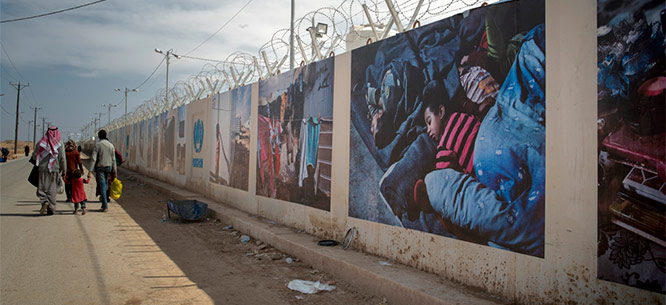
In late July 2012, the first Syrian families arrived at the Za’atari refugee camp, a barren strip of land twelve kilometers from the Syrian border and seventy kilometers from the Jordanian capital, Amman.
At the time, Andrew Harper, UNHCR’s Country Representative in Jordan said, “We are the first to admit that it is a hot desolate location. Nobody wants to put a family who has already suffered so much in a tent, in the desert, but we have no choice.”
By the end of that summer, the camp housed over 28,000 refugees. In March 2013, 156,000 people were living in a space designed for 113,000. The windswept camp had become Jordan’s fourth largest city, and UNHCR’s second largest camp after Dadaab in Kenya, currently home to about 328,000 displaced Somalis. Today, of the close to 700,000 registered Syrian refugees in Jordan, Za’atari houses about 80,000 residents.
In July 2013 U.S. Secretary of State John Kerry arrived by helicopter to visit the camp. Agence France-Presse photographer Mandel Ngan’s aerial photographs of Za’atari became the defining images of the visit. In these images, people appear as dots, little specks in brown sand against an undulating grid of tents and container homes, with no end in sight. The photographs evoked the enormity of the Syrian refugee crisis. They were powerful, but also impersonal.
As the Za’atari camp grew, the camp’s security architecture evolved.
Just past the checkpoint entrance is the camp’s main road bordered on one side by a barbed-wire security wall that stands 2.44 meters high and 120 meters long. This is the largest and most prominent in a series of walls encircling service areas and UNHCR buildings.
In late December 2013 and early January 2014, along with three experienced photographers, I visited the camp to capture the daily life of its residents. Our aim was to tell a story about the camp through images and to paste these photos on the security wall, transforming the concrete barrier into a massive narrative canvas. The photographic display would be visible to both the subjects of the photographs and to visitors, diplomats, and other actors who would decide the fate of the refugees living within.
Rather than unidentifiable specks in brown sand, we wanted Za’atari’s refugees to appear epic, but also to show their humanity and dignity. The project used the visual language of photojournalism but required consent and collaboration from the camp’s residents. In addition, the images had to strike a particular note: they had to negotiate the space between the grim reality of the camp and the project’s intention to use art as an affirming medium in spaces of disenfranchisement and trauma.
When escaping violence, refugees flee with what they can carry. Many left behind their family photographs. So in addition to the creation of the security wall mural, our team of photographers turned one tent into a photo studio. Refugees were invited to have their portraits taken alone or with someone—or something—they loved. One man brought his shisha; a young boy, his blanket. Four girls held their schoolbooks. Mothers carried babies. A father stood behind his son. The photo studio provided a neutral space where residents could momentarily escape their refugee status. Participants were treated as clients, not subjects. They chose how they would pose and look. We printed hundreds of these portraits and distributed them for free on the spot. I also selected a few images for the security wall mural.
In March 2014, we pasted the photographs on the wall and it came alive.
People drove by honking their horns, giving the thumbs-up sign. Some walked by in careful contemplation, taking in each picture. Others, however, were less positive. One refugee, a former fighter who had first agreed to be photographed outside his tent, became self-conscious once he saw his image enlarged. We covered the picture at his request. The Jordanian authorities (who had not been given prior review) grew agitated during the installation process. They questioned whether some of the images portrayed the camp, and by extension, the host country, in a negative light. For example, a photo of a man holding up X-rays of injuries he had suffered in Syria could be mistaken for injuries received at the camp. Another depicting the daily ritual of bread distribution could give the impression, authorities said, that everyone in the camp was poor and hungry.
The pictures were designed to have a six-month life span. But the majority of the nearly one hundred images still remain on the security wall today. They are discolored and frayed, washed out by the passage of time, yet the faces of the refugees are still discernible on the concrete slabs. Their photographs are now testament to the duration of the refugee crisis and the permanence of the camp.
Nina Berman is a documentary photographer, author of Purple Hearts: Back from Iraq (Trolley Books, 2004), and Homeland (Trolley Books, 2008), and an associate professor at the Columbia University Graduate School of Journalism. The Za’atari project was produced by Nina Berman and NOOR images, and photographed by Stanley Greene, Alixandra Fazzina, Andrea Bruce, and Nina Berman. Curator Sam Barzilay assisted with installation.
CAPTION -->

Sign up for the Dissent newsletter:
Socialist thought provides us with an imaginative and moral horizon.
For insights and analysis from the longest-running democratic socialist magazine in the United States, sign up for our newsletter:
Photo essay: In DRC, women refugees rebuild lives, with determination and hope
Date: 18 May 2016
Burundi’s ongoing political turmoil has caused hundreds of thousands to flee their homes and seek shelter in neighbouring Democratic Republic of Congo (DRC). At the Lusenda refugee camp, which is home to more than 16,000 refugees, the majority are women and girls. Hundreds of refugees have come to the Safe Haven multipurpose centres for protection and economic and social empowerment, established by UN Women [ 1 ]. Here’s a glimpse into daily life at the camp and the centres.
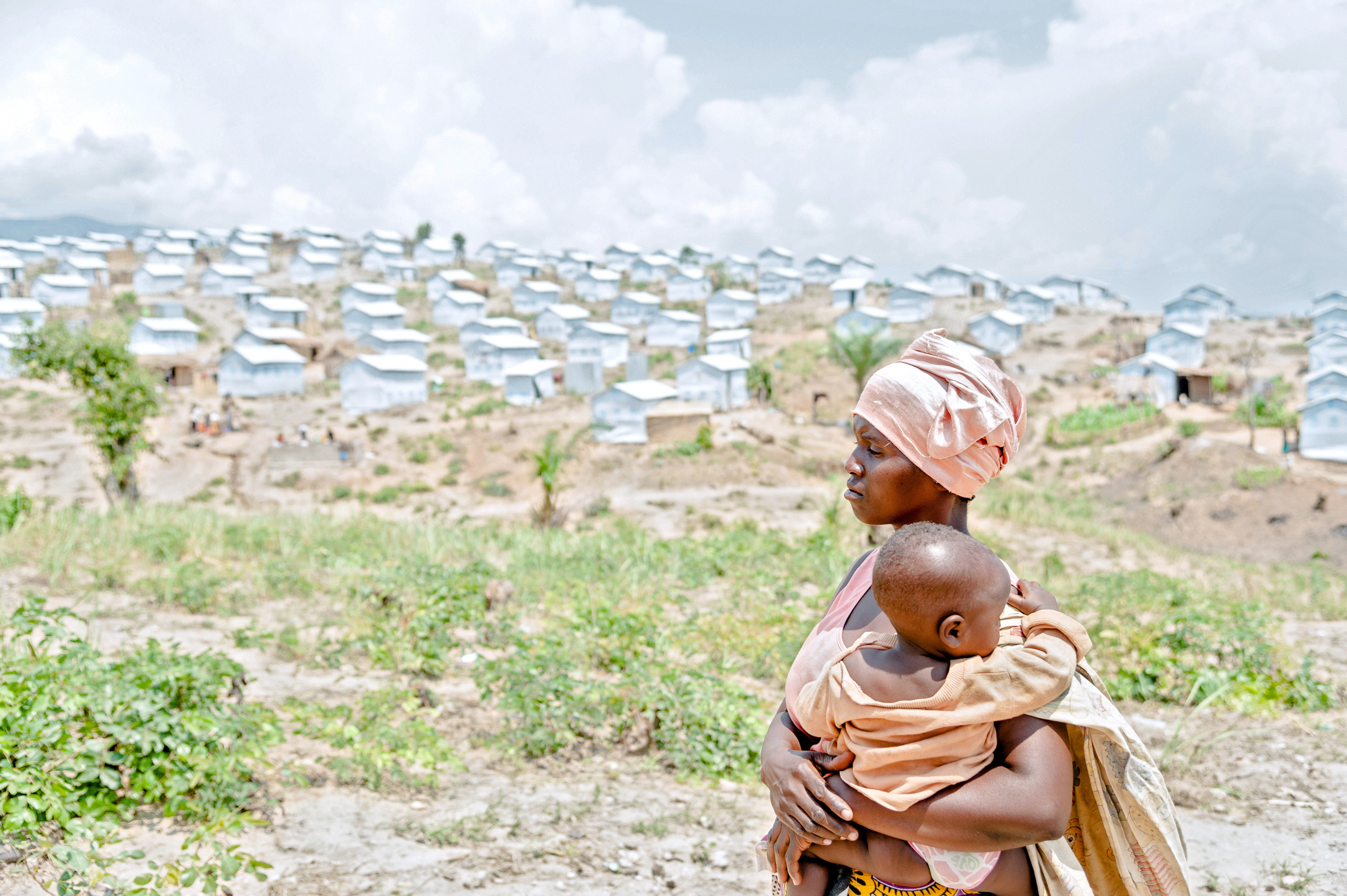
When her husband was arrested during the 2015 political crisis, Luscie, 32, fled the Bujumbura province in Burundi with her eight children, with only the clothes on their backs. Since then they have been refugees at the Lusenda camp in DRC.
Photo: UN Women/Catianne Tijerina
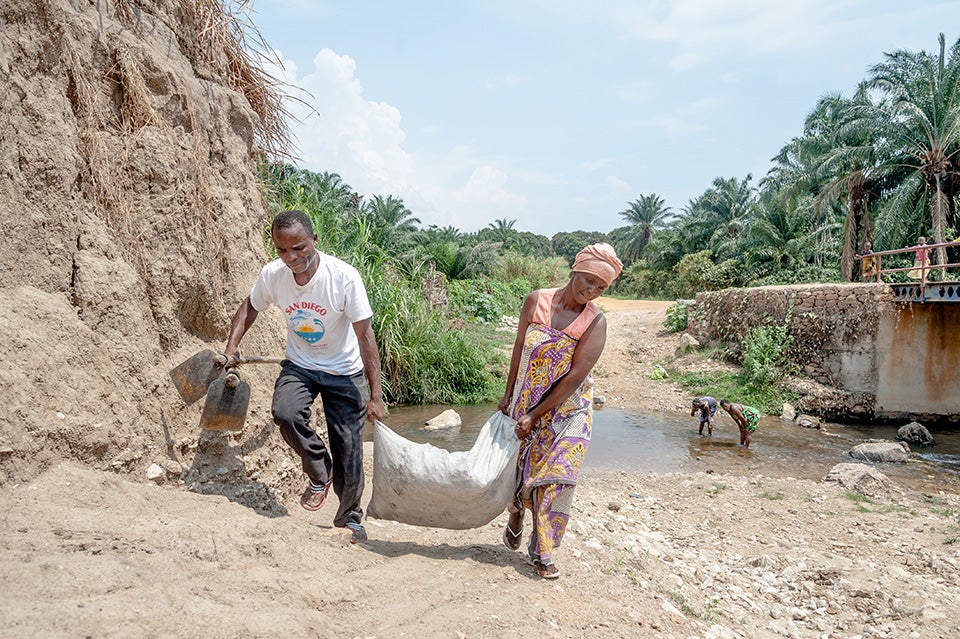
With the help of a camp worker, Luscie, right, hauls rock and clay from a river back to a UN Women multipurpose centre for use in building a clay stove. UN Women has established three Safe Haven multipurpose centres, which offer psychosocial counselling, referrals, skills training and cash-for-work programmes.
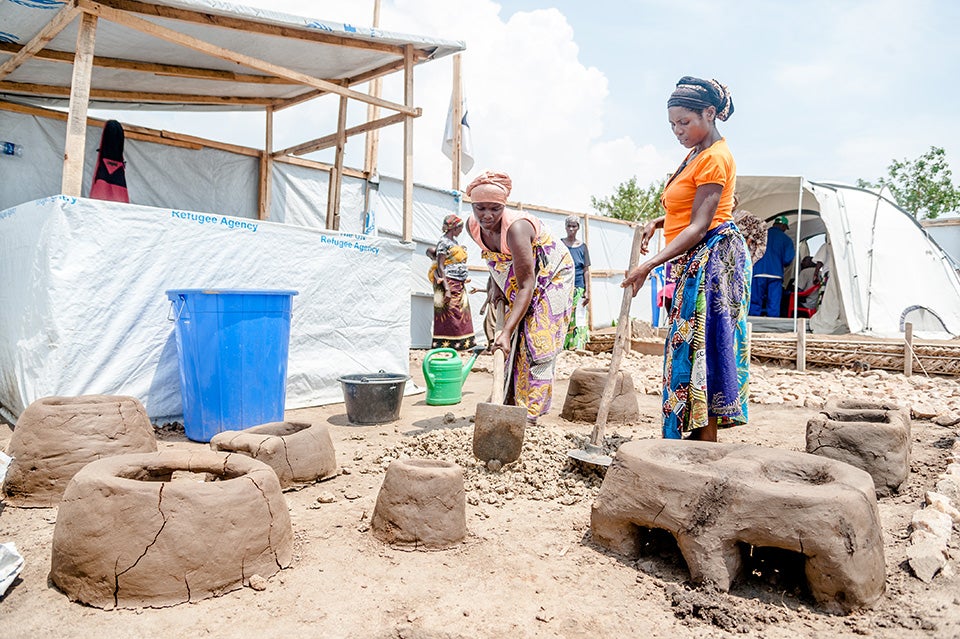
Luscie, left, and Marita, right, work to make a handmade clay stove. At the multipurpose centres, they’ve learned to make stoves which help cut the cost of feeding their families. “It takes less charcoal and the surface stays hot longer,” says Marita.
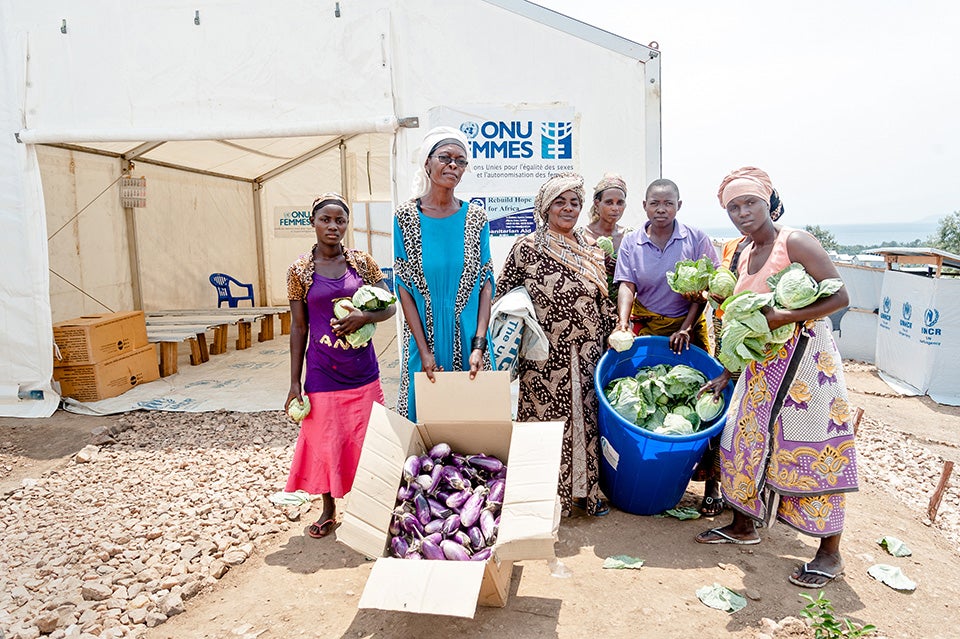
Also at the multipurpose centre, Luscie, far right, joined the collective efforts to cultivate vegetables for a shared profit. Her goal: to make enough money to replace her children’s torn clothes.
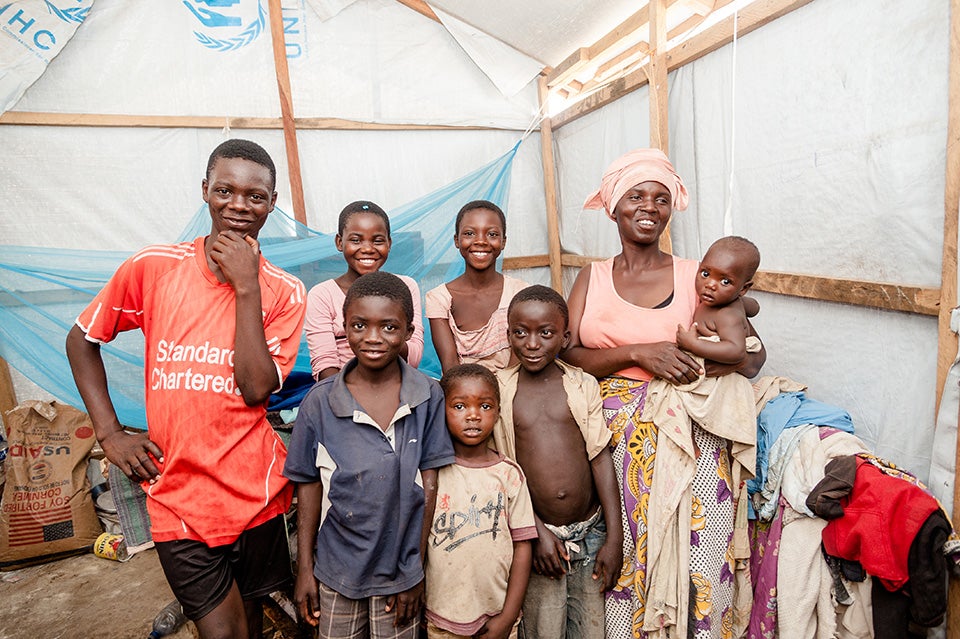
Luscie with her children. Many women in the camp are widows and have had to become heads of their households, taking on the responsibility for the children, the sick or the elderly. They need services and resources. Through the multipurpose centres, nearly 300 women in Lusenda have gained temporary employment through cash-for-work programmes. Another 80 women and girls acquired soap-making skills and 38 learned how to operate a camp restaurant.
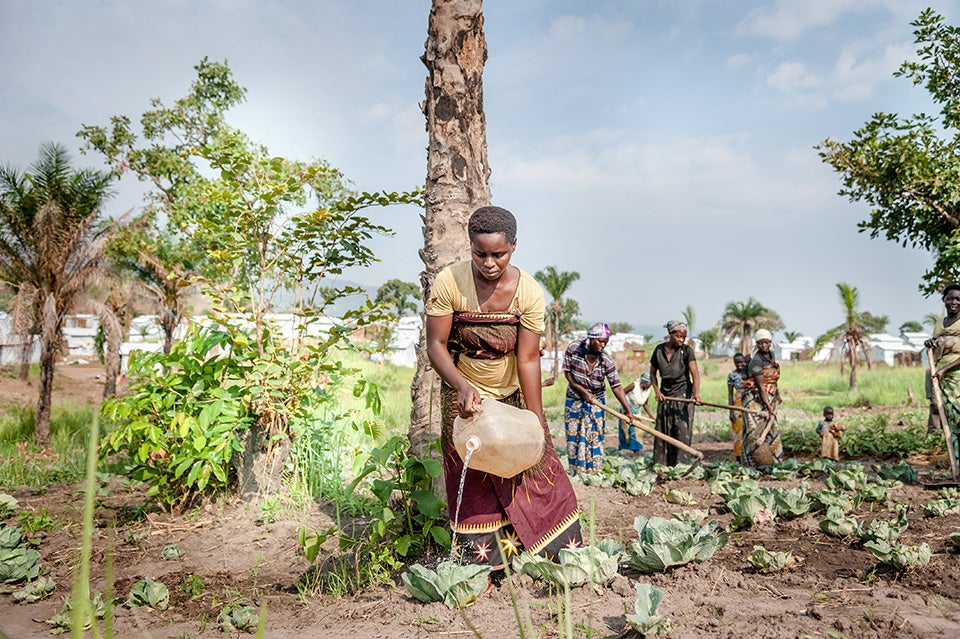
Women who are part of the agriculture programme gather early to attend to the crops they cultivate collectively.
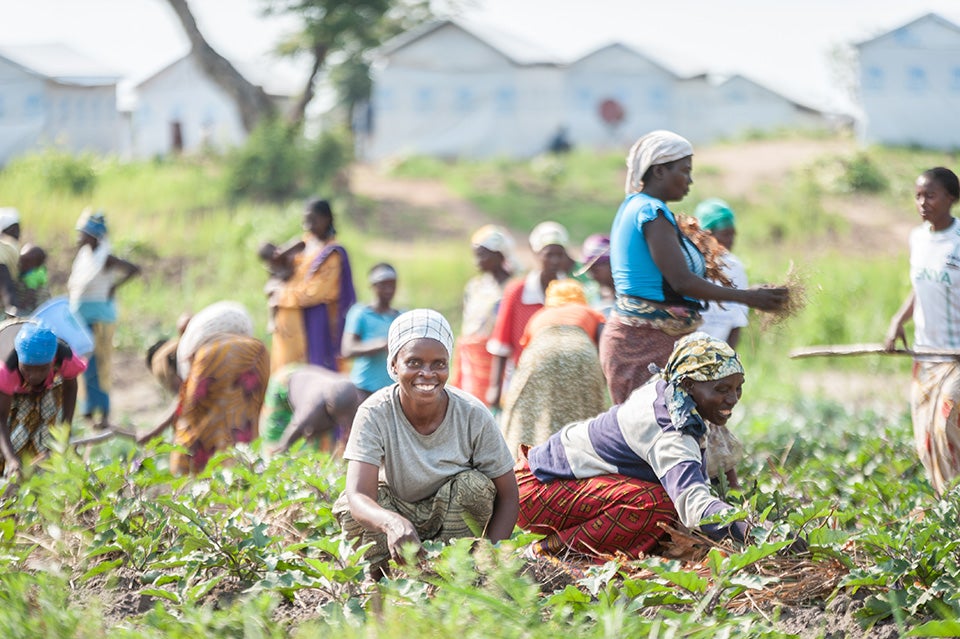
The women learn how to plant many different kinds of crops. After working in the collective, some of them are able to plant and harvest vegetables outside of their temporary houses at the refugee camp.
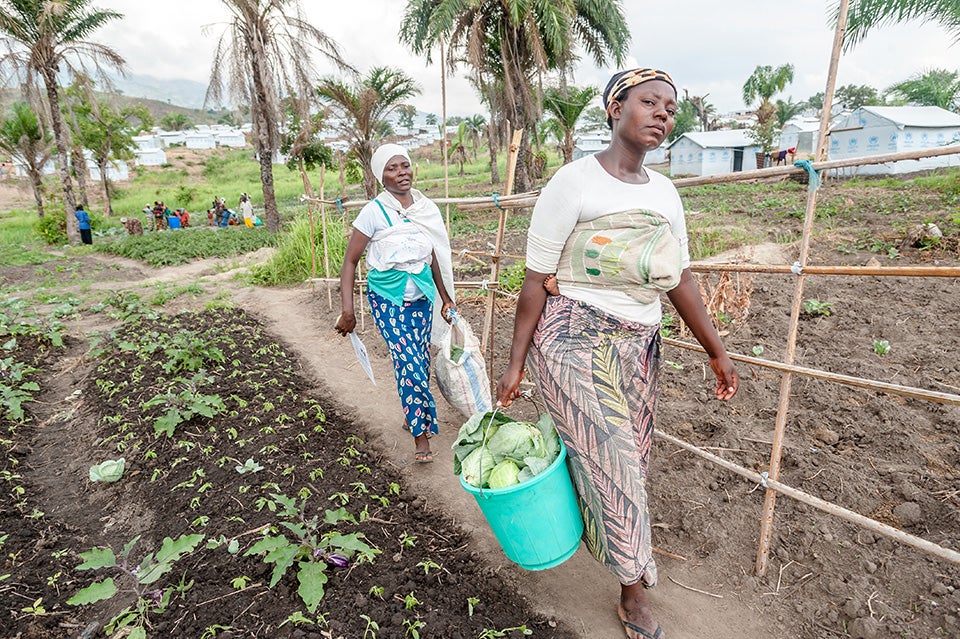
With UN Women’s assistance, in 2015, 264 women refugees contributed to the camp’s food security after being trained to grow vegetables.
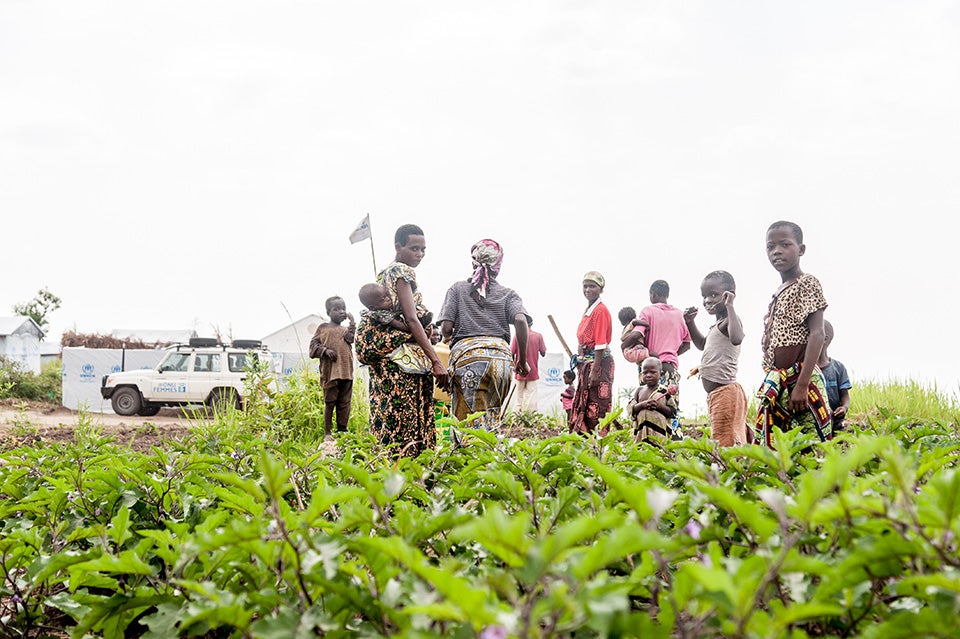
After finishing their morning’s work, the women often walk back to the UN Women multipurpose centre, where they can also find information on women’s rights and receive psychological support and counselling. In the camp, refugee women face social isolation, harassment, domestic violence and other types of sexual and gender-based violence.
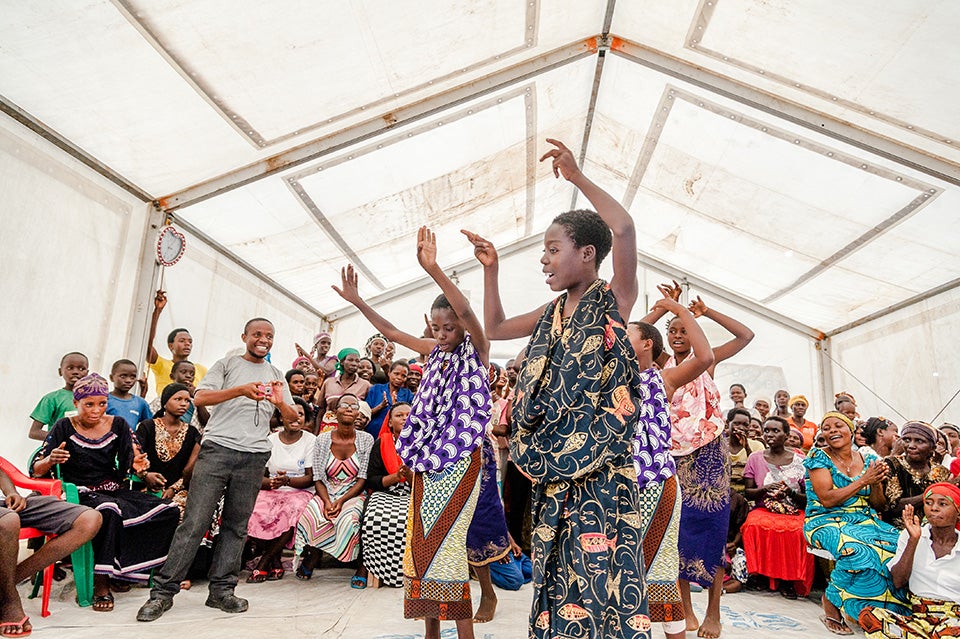
Celestine, a refugee at the Lusenda camp, leads a dance performance organized by youth at a multipurpose centre in October 2015. The centres also serve as safe spaces for women to feel comfortable and express themselves, without the fear of judgement or harm.
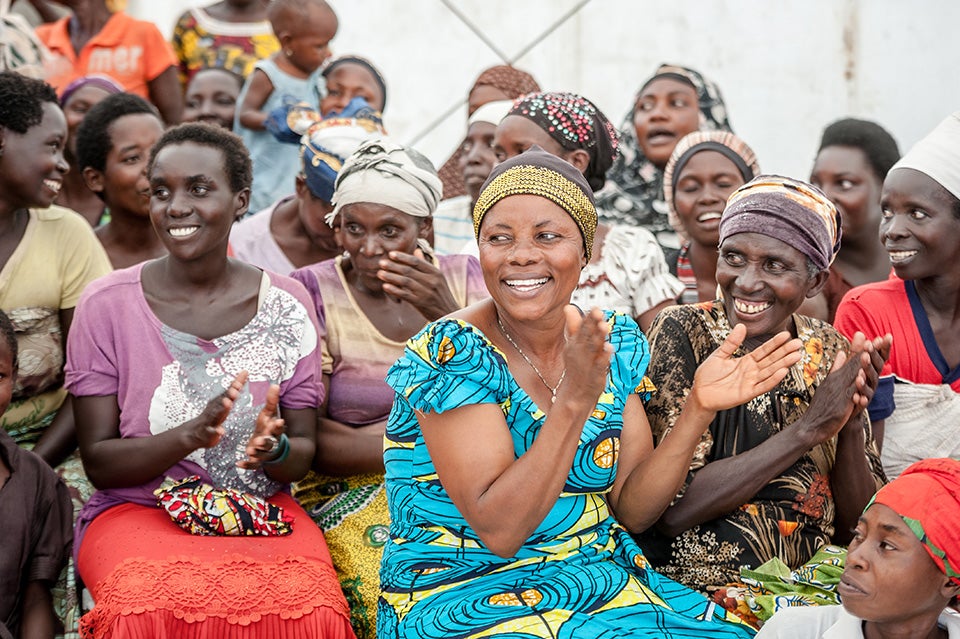
In the midst of all the daily challenges, women attending the dance performance have a moment to laugh together. One of the goals of the centres is to help refugee women socialize, make new friends and rebuild their social networks. “We should not give up but fight for a better life for our children!” say the women in the Lusenda refugee camp.
UN Women works so that women and girls in protracted crises have access to the services they need to ensure their recovery and develop their resilience to future crises.
For larger-format images, you can also find this photo essay cross-posted on Medium .
For more information on Women in Humanitarian Action, visit our In Focus section .
[1] The UN Women multipurpose centres are run in partnership with the United Nations High Commission for Refugees (UNHCR), its local partner Rebuild Hope for Africa and the Women Refugee Committee, with funding from the Government of Japan.
- ‘One Woman’ – The UN Women song
- UN Under-Secretary-General and UN Women Executive Director Sima Bahous
- Kirsi Madi, Deputy Executive Director for Resource Management, Sustainability and Partnerships
- Nyaradzayi Gumbonzvanda, Deputy Executive Director for Normative Support, UN System Coordination and Programme Results
- Guiding documents
- Report wrongdoing
- Programme implementation
- Career opportunities
- Application and recruitment process
- Meet our people
- Internship programme
- Procurement principles
- Gender-responsive procurement
- Doing business with UN Women
- How to become a UN Women vendor
- Contract templates and general conditions of contract
- Vendor protest procedure
- Facts and Figures
- Global norms and standards
- Women’s movements
- Parliaments and local governance
- Constitutions and legal reform
- Preguntas frecuentes
- Global Norms and Standards
- Macroeconomic policies and social protection
- Sustainable Development and Climate Change
- Rural women
- Employment and migration
- Facts and figures
- Creating safe public spaces
- Spotlight Initiative
- Essential services
- Focusing on prevention
- Research and data
- Other areas of work
- UNiTE campaign
- Conflict prevention and resolution
- Building and sustaining peace
- Young women in peace and security
- Rule of law: Justice and security
- Women, peace, and security in the work of the UN Security Council
- Preventing violent extremism and countering terrorism
- Planning and monitoring
- Humanitarian coordination
- Crisis response and recovery
- Disaster risk reduction
- Inclusive National Planning
- Public Sector Reform
- Tracking Investments
- Strengthening young women's leadership
- Economic empowerment and skills development for young women
- Action on ending violence against young women and girls
- Engaging boys and young men in gender equality
- Sustainable development agenda
- Leadership and Participation
- National Planning
- Violence against Women
- Access to Justice
- Regional and country offices
- Regional and Country Offices
- Liaison offices
- UN Women Global Innovation Coalition for Change
- Commission on the Status of Women
- Economic and Social Council
- General Assembly
- Security Council
- High-Level Political Forum on Sustainable Development
- Human Rights Council
- Climate change and the environment
- Other Intergovernmental Processes
- World Conferences on Women
- Global Coordination
- Regional and country coordination
- Promoting UN accountability
- Gender Mainstreaming
- Coordination resources
- System-wide strategy
- Focal Point for Women and Gender Focal Points
- Entity-specific implementation plans on gender parity
- Laws and policies
- Strategies and tools
- Reports and monitoring
- Training Centre services
- Publications
- Government partners
- National mechanisms
- Civil Society Advisory Groups
- Benefits of partnering with UN Women
- Business and philanthropic partners
- Goodwill Ambassadors
- National Committees
- UN Women Media Compact
- UN Women Alumni Association
- Editorial series
- Media contacts
- Annual report
- Progress of the world’s women
- SDG monitoring report
- World survey on the role of women in development
- Reprint permissions
- Secretariat
- 2023 sessions and other meetings
- 2022 sessions and other meetings
- 2021 sessions and other meetings
- 2020 sessions and other meetings
- 2019 sessions and other meetings
- 2018 sessions and other meetings
- 2017 sessions and other meetings
- 2016 sessions and other meetings
- 2015 sessions and other meetings
- Compendiums of decisions
- Reports of sessions
- Key Documents
- Brief history
- CSW snapshot
- Preparations
- Official Documents
- Official Meetings
- Side Events
- Session Outcomes
- CSW65 (2021)
- CSW64 / Beijing+25 (2020)
- CSW63 (2019)
- CSW62 (2018)
- CSW61 (2017)
- Member States
- Eligibility
- Registration
- Opportunities for NGOs to address the Commission
- Communications procedure
- Grant making
- Accompaniment and growth
- Results and impact
- Knowledge and learning
- Social innovation
- UN Trust Fund to End Violence against Women
- About Generation Equality
- Generation Equality Forum
- Action packs

- High contrast
- Press Centre
Search UNICEF
The things we hold on to: refugee children carry memories of home, no matter where they’re from or why they left, refugee and displaced children are children first..

What would you take if you had only hours – even minutes – to decide before being forced to flee your home? And what if you didn’t know how long you’d be gone, or what would be left of your home should you return?
These are questions that a growing number of refugees have had to confront as new waves of violence and protracted crises worldwide uproot millions from their homes. But even as the global refugee population has more than doubled in the past decade, refugee and displaced children – from Afghanistan to South Sudan to Syria to Ukraine – have something important in common: They all have equal rights. And they need our support to grow, to learn and to thrive in safety.

Zaina took a framed photograph of her late father when she fled Syria for the Za’atari refugee camp in Jordan. “I wanted to bring this with me when I came here. It was hanging on the wall. I saw my mother putting stuff together, so I ran to the photo and took it off the wall and put it in her bag,” Zaina says. “I have many memories of all the toys he gave me. I couldn’t bring those with me.”

Maksym fled eastern Ukraine with his mother and brother as the war escalated. “[We] had to flee because they were shelling,” Maksym says. He was supposed to play his first concert on the piano the week he left. His musical score was among the few precious things he was able to pack and take with him.

Ayoub packed a set of spoons when he fled Syria. “I wanted to take them with me as a memory, so I grabbed them as we were leaving the house and I carried them the whole way here,” says Ayoub, now in the Za’atari refugee camp in Jordan. “I used to eat my meals with them back at home, so I thought that I’m going to need them to eat when I come to the camp.”

Andaili holds up her family photo album, her most prized possession, which she brought from Venezuela to her new home in Colombia.

Nilufar is Afghan by descent but has never lived in Afghanistan. She was born a refugee in Pakistan before her family sought safety in Iran, Turkey, Greece, and then in Serbia.
“I don't have any more photographs, just this one,” she says, carefully unwrapping a framed photo of herself. “This is me wearing the religious headscarf I got from my school when I completed the third grade in Iran. All the children got the same headscarves back then.”

Yonas left his home in Eritrea due to instability in the country. He crossed Ethiopia, Sudan and Libya, hitching rides in cars and trucks. He was then evacuated by UNHCR (the UN Refugee Agency) to Niamey, Niger. He found a yellow hat while he was in Libya. “Since then, I keep it with me, even in Niger!” he says. “It protected me during cold nights. Now it has become special to me.”

Agnes holds her baby boy’s knitted hat in the Bidibidi refugee settlement, north-western Uganda. She fled South Sudan, in the midst of conflict, where the war and instability had created a severe food crisis. Her baby contracted malaria during the journey to Uganda. He passed away just days after their arrival at the settlement.

Fourteen-year-old Rohingya refugee Tasmin Akter holds her favourite book of poetry at a UNICEF-supported project in Kutupalong refugee camp, Cox’s Bazar District, Bangladesh. “When I take a decision for myself, like deciding to read a Bengali poem at home, I feel strong,” says Tasmin.

“I brought this dog,” says Shatha, 15, as she holds the small toy in her hands. She was 9 when she left Syria. “When we had to leave, I had so many toys to choose from, but he was my favourite.” She says she held him the whole way to the Za’atari camp. “I never let go of my dog so he could protect me. My toy dog will always be with me. I’ll tell my children my whole life story and his – because it’s the same as mine.”

Tatiana brought her dog with her to a temporary refugee centre in Moldova near the border with Ukraine. “I’m worried about my sister who’s hospitalized in Ukraine, and my brother,” Tatiana says. “I just want to go back home. I don’t want there to be a war.”
Reaching safety is just the start. Once out of harm’s way, refugee children and their families need opportunities to heal, learn and thrive. UNICEF stands in solidarity with all refugee children – because wherever they come from, whenever they’re forced to flee, all refugee children have equal rights. They all need our support. Read more about UNICEF’s work for migrant and displaced children and six actions that must be taken to achieve equal rights and opportunities for all refugee children.
Related topics
More to explore.
Nearly 37 million children displaced worldwide – highest number ever recorded
Migrant and displaced children
Children on the move are children first
Six actions for refugee children
Ensuring equal rights and opportunities for all refugee children
UNICEF in emergencies
Humanitarian action is central to UNICEF’s mandate and realizing the rights of every child

Search the United Nations
- Policy and Funding
- Recover Better
- Disability Inclusion
- Secretary-General
- Financing for Development
- ACT-Accelerator
- Member States
- Health and Wellbeing
- Policy and Guidance
- Vaccination
- COVID-19 Medevac
- i-Seek (requires login)
- Awake at Night podcast

COVID-19 photo essay: We’re all in this together
About the author, department of global communications.
The United Nations Department of Global Communications (DGC) promotes global awareness and understanding of the work of the United Nations.
23 June 2020 – The COVID-19 pandemic has demonstrated the interconnected nature of our world – and that no one is safe until everyone is safe. Only by acting in solidarity can communities save lives and overcome the devastating socio-economic impacts of the virus. In partnership with the United Nations, people around the world are showing acts of humanity, inspiring hope for a better future.
Everyone can do something

Rauf Salem, a volunteer, instructs children on the right way to wash their hands, in Sana'a, Yemen. Simple measures, such as maintaining physical distance, washing hands frequently and wearing a mask are imperative if the fight against COVID-19 is to be won. Photo: UNICEF/UNI341697
Creating hope

Venezuelan refugee Juan Batista Ramos, 69, plays guitar in front of a mural he painted at the Tancredo Neves temporary shelter in Boa Vista, Brazil to help lift COVID-19 quarantine blues. “Now, everywhere you look you will see a landscape to remind us that there is beauty in the world,” he says. Ramos is among the many artists around the world using the power of culture to inspire hope and solidarity during the pandemic. Photo: UNHCR/Allana Ferreira
Inclusive solutions

Wendy Schellemans, an education assistant at the Royal Woluwe Institute in Brussels, models a transparent face mask designed to help the hard of hearing. The United Nations and partners are working to ensure that responses to COVID-19 leave no one behind. Photo courtesy of Royal Woluwe Institute
Humanity at its best

Maryna, a community worker at the Arts Centre for Children and Youth in Chasiv Yar village, Ukraine, makes face masks on a sewing machine donated by the Office of the United Nations High Commissioner for Refugees (UNHCR) and civil society partner, Proliska. She is among the many people around the world who are voluntarily addressing the shortage of masks on the market. Photo: UNHCR/Artem Hetman
Keep future leaders learning

A mother helps her daughter Ange, 8, take classes on television at home in Man, Côte d'Ivoire. Since the COVID-19 pandemic began, caregivers and educators have responded in stride and have been instrumental in finding ways to keep children learning. In Côte d'Ivoire, the United Nations Children’s Fund (UNICEF) partnered with the Ministry of Education on a ‘school at home’ initiative, which includes taping lessons to be aired on national TV and radio. Ange says: “I like to study at home. My mum is a teacher and helps me a lot. Of course, I miss my friends, but I can sleep a bit longer in the morning. Later I want to become a lawyer or judge." Photo: UNICEF/UNI320749
Global solidarity

People in Nigeria’s Lagos State simulate sneezing into their elbows during a coronavirus prevention campaign. Many African countries do not have strong health care systems. “Global solidarity with Africa is an imperative – now and for recovering better,” said United Nations Secretary-General António Guterres. “Ending the pandemic in Africa is essential for ending it across the world.” Photo: UNICEF Nigeria/2020/Ojo
A new way of working

Henri Abued Manzano, a tour guide at the United Nations Information Service (UNIS) in Vienna, speaks from his apartment. COVID-19 upended the way people work, but they can be creative while in quarantine. “We quickly decided that if visitors can’t come to us, we will have to come to them,” says Johanna Kleinert, Chief of the UNIS Visitors Service in Vienna. Photo courtesy of Kevin Kühn
Life goes on

Hundreds of millions of babies are expected to be born during the COVID-19 pandemic. Fionn, son of Chloe O'Doherty and her husband Patrick, is among them. The couple says: “It's all over. We did it. Brought life into the world at a time when everything is so uncertain. The relief and love are palpable. Nothing else matters.” Photo: UNICEF/UNI321984/Bopape
Putting meals on the table

Sudanese refugee Halima, in Tripoli, Libya, says food assistance is making her life better. COVID-19 is exacerbating the existing hunger crisis. Globally, 6 million more people could be pushed into extreme poverty unless the international community acts now. United Nations aid agencies are appealing for more funding to reach vulnerable populations. Photo: UNHCR
Supporting the frontlines

The United Nations Air Service, run by the World Food Programme (WFP), distributes protective gear donated by the Jack Ma Foundation and Alibaba Group, in Somalia. The United Nations is using its supply chain capacity to rapidly move badly needed personal protective equipment, such as medical masks, gloves, gowns and face-shields to the frontline of the battle against COVID-19. Photo: WFP/Jama Hassan

S7-Episode 2: Bringing Health to the World
“You see, we're not doing this work to make ourselves feel better. That sort of conventional notion of what a do-gooder is. We're doing this work because we are totally convinced that it's not necessary in today's wealthy world for so many people to be experiencing discomfort, for so many people to be experiencing hardship, for so many people to have their lives and their livelihoods imperiled.”
Dr. David Nabarro has dedicated his life to global health. After a long career that’s taken him from the horrors of war torn Iraq, to the devastating aftermath of the Indian Ocean tsunami, he is still spurred to action by the tremendous inequalities in global access to medical care.
“The thing that keeps me awake most at night is the rampant inequities in our world…We see an awful lot of needless suffering.”
:: David Nabarro interviewed by Melissa Fleming

Brazilian ballet pirouettes during pandemic
Ballet Manguinhos, named for its favela in Rio de Janeiro, returns to the stage after a long absence during the COVID-19 pandemic. It counts 250 children and teenagers from the favela as its performers. The ballet group provides social support in a community where poverty, hunger and teen pregnancy are constant issues.

Radio journalist gives the facts on COVID-19 in Uzbekistan
The pandemic has put many people to the test, and journalists are no exception. Coronavirus has waged war not only against people's lives and well-being but has also spawned countless hoaxes and scientific falsehoods.
Yemeni refugees seek shelter in Djibouti (Photo Essay)

Oualid Khelifi, Al Jazeera, 14 Nov 2015
URL: http://www.aljazeera.com/indepth/inpictures/2015/11/yemeni-refugees-seek-shelter-djibouti-151113094929289.html
Available layouts.
Yemeni refugees seek shelter in Djibouti (Photo Essay)

Oualid Khelifi, Al Jazeera, 14 Nov 2015
URL: http://www.aljazeera.com/indepth/inpictures/2015/11/yemeni-refugees-seek-shelter-djibouti-151113094929289.html
Available layouts.
About . Click to expand section.
- Our History
- Team & Board
- Transparency and Accountability
What We Do . Click to expand section.
- Cycle of Poverty
- Climate & Environment
- Emergencies & Refugees
- Health & Nutrition
- Livelihoods
- Gender Equality
- Where We Work
Take Action . Click to expand section.
- Attend an Event
- Partner With Us
- Fundraise for Concern
- Work With Us
- Leadership Giving
- Humanitarian Training
- Newsletter Sign-Up
Donate . Click to expand section.
- Give Monthly
- Donate in Honor or Memory
- Leave a Legacy
- DAFs, IRAs, Trusts, & Stocks
- Employee Giving
Photo essay: The reality for those fleeing Ukraine
More than 1 million people have fled Ukraine in just the first week of conflict, and thousands more are on the move.
Mar 4, 2022 | By: Kieran McConville
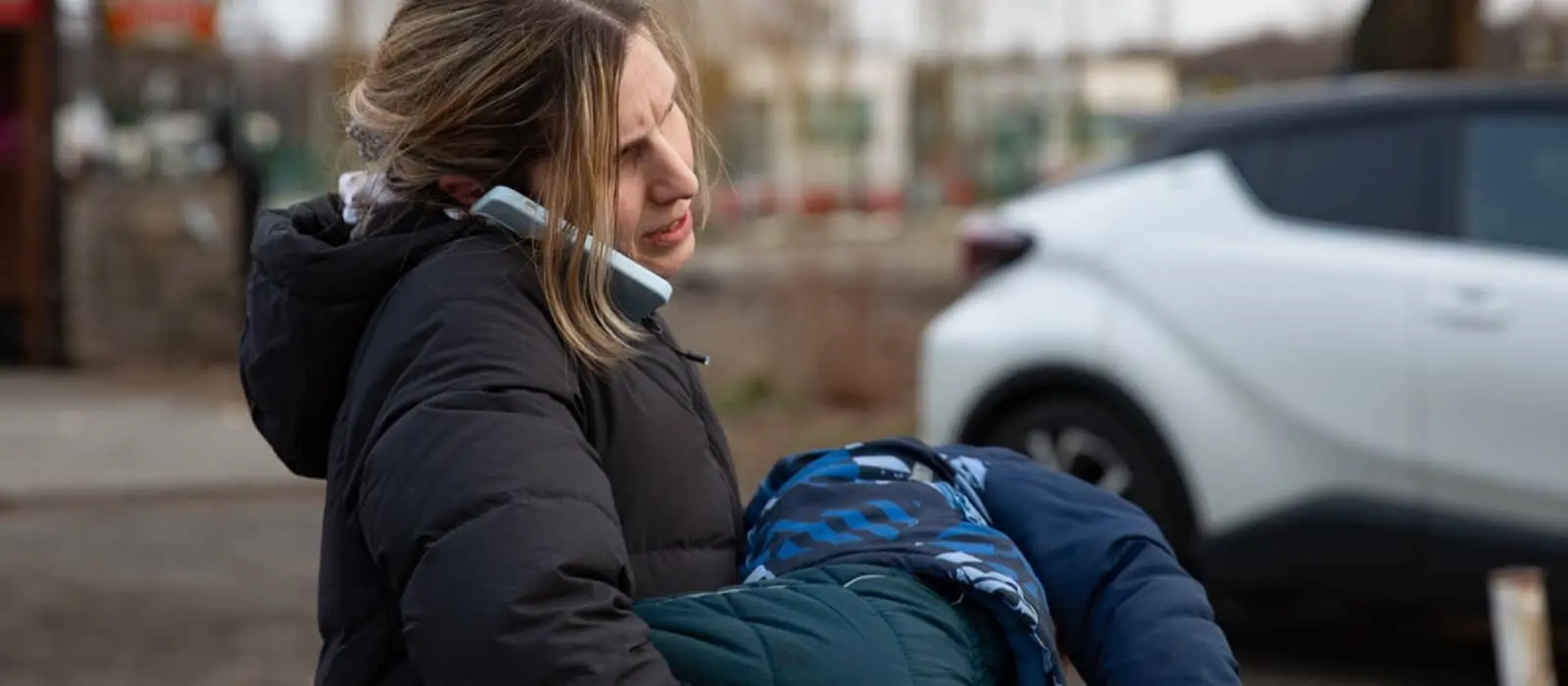
In search of safety, more than 1 million people fled Ukraine in the last week and thousands more are on the move. The UNHCR estimates it could be the biggest refugee crisis of the century.
Most of the refugees crossing the border into Poland, Slovakia, Romania, Hungary, and Moldova are women and children. In pictures, this is the reality for people fleeing the crisis in Ukraine.

Get updates from our work in Ukraine as it develops
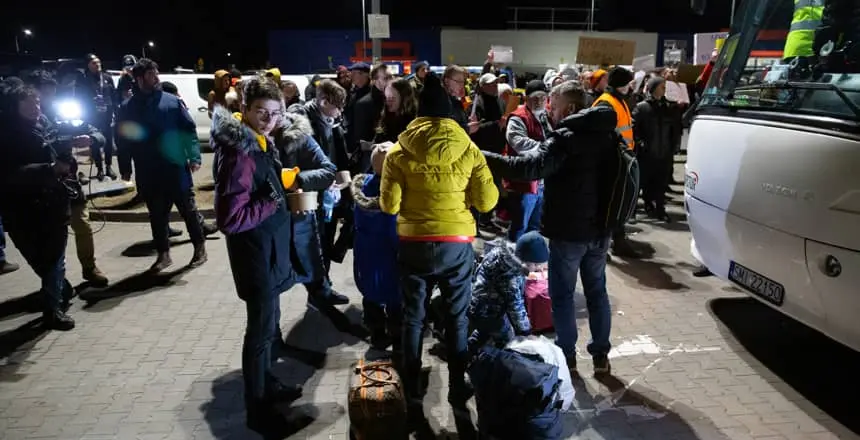
More from Ukraine
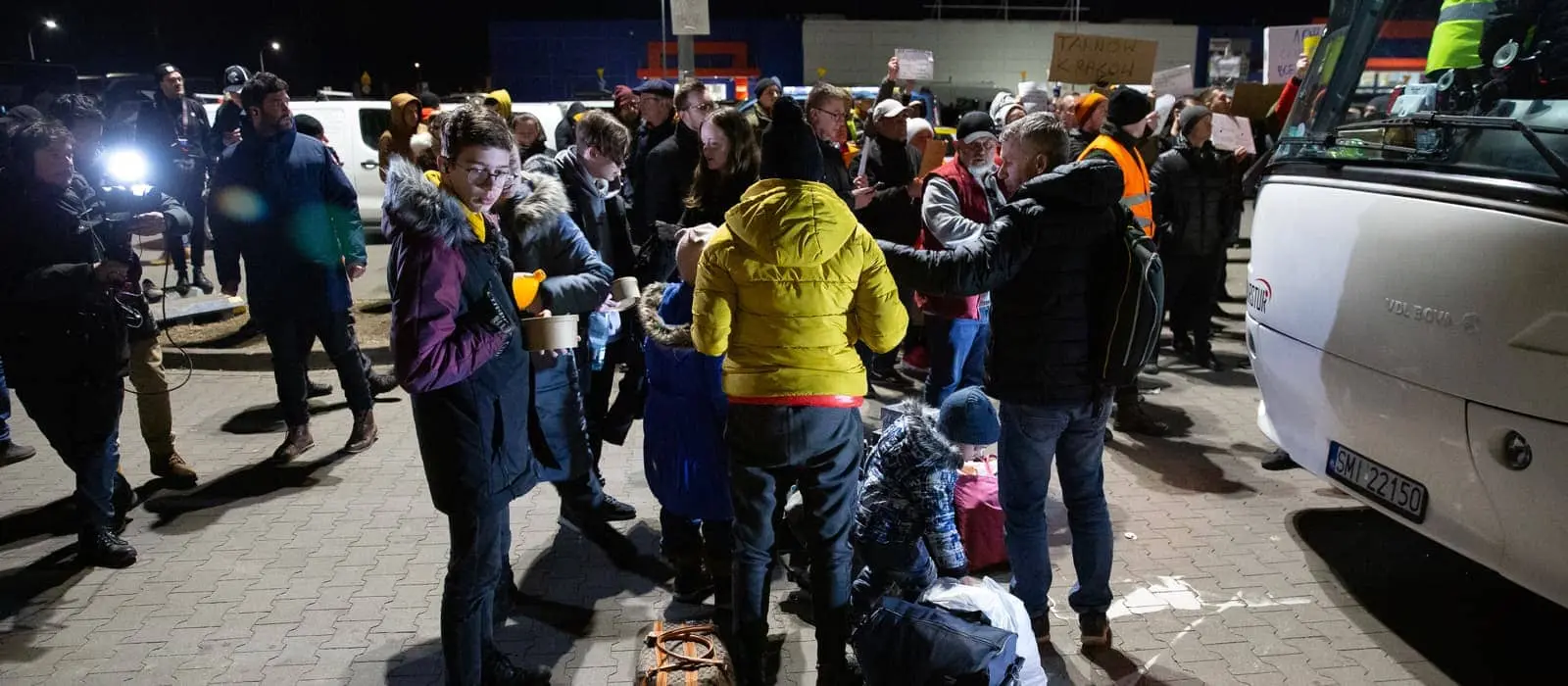
From the Ukrainian border
Sign up for our newsletter.
Get emails with stories from around the world.
You can change your preferences at any time. By subscribing, you agree to the Terms of Use and Privacy Policy.
- Search Menu
- Advance articles
- Special Issues
- Editor's Choice
- Submission Site
- Author Guidelines
- Open Access
- About Journal of Refugee Studies
- Editorial Board
- Early-Career Researcher Prize
- Advertising and Corporate Services
- Journals Career Network
- Self-Archiving Policy
- Books for Review
- Dispatch Dates
- Journals on Oxford Academic
- Books on Oxford Academic
Article Contents
Introduction, challenging sociopolitical contexts, the corporatization of the humanitarian industry, humanitarian communication strategies, social media opportunities and challenges for humanitarian organizations, methodology, discussion and conclusion, acknowledgements, author contributions, disclosure statement, data availability, beyond victim and hero representations a comparative analysis of unhcr’s instagram communication strategies for the syrian and ukrainian crises.
- Article contents
- Figures & tables
- Supplementary Data
David Ongenaert, Claudia Soler, Beyond victim and hero representations? A comparative analysis of UNHCR’s Instagram communication strategies for the Syrian and Ukrainian crises, Journal of Refugee Studies , 2024;, feae035, https://doi.org/10.1093/jrs/feae035
- Permissions Icon Permissions
The Ukrainian crisis has received substantial Global Northern policy support and favourable news coverage, contrasting sharply with Global Southern crises. Nevertheless, refugee organizations can influence public perceptions through social media. This study comparatively analyses UNHCR’s Instagram communication strategies for the Ukrainian and Syrian crises (2022–2023). Applying a multimodal critical discourse analysis on UNHCR’s Instagram posts (N = 90), we discern interacting humanitarian and post-humanitarian appeals, involving inter- and intra-group hierarchies of deservingness, expanding research on humanitarian communication. While UNHCR mainly represents forcibly displaced Ukrainians as victims and focuses on ‘ideal victims’, it mostly portrays forcibly displaced Syrians as empowered individuals, likely due to context-specific differences and partially countering news and policy narratives. Both humanitarian representations often intersect with post-humanitarian strategies, facilitated by Instagram affordances. This study thus contributes to the literature on humanitarian communication with comparative crisis-specific and platform-specific insights and causes. Moreover, it nuances the often-assumed importance of post-humanitarian imageries on social media.
The Ukrainian-Russian war has led to one of the largest crises of modern times, involving 11.6 million forcibly displaced Ukrainians at the end of 2022 ( UNHCR 2023 ). Many European countries, including those with anti-migration sentiments, are promoting solidarity with Ukrainian refugees. This is illustrated by the European Union’s (EU) first activation of the Temporary Protection Directive since its adoption in 2001, which prioritizes prompt and efficient assistance rather than individual asylum application processing. This approach contrasts sharply with the EU’s much more restrictive policies towards refugees from the Middle East and North Africa (MENA), including Syria ( Moallin et al. 2023 ). Similarly, Western news media often portray forcibly displaced Ukrainians more positively as contingent, legitimate, innocent and/or resilient victims, while those from the MENA as passive victims and/or threats, constructing hierarchies of deservingness. Various media have bluntly justified these double standards by arguing that Ukrainians resemble more their host populations: European, Christian, and white ( Zawadzka-Paluektau 2023 ).
In these challenging contexts, international refugee organizations often play important roles. They provide humanitarian assistance and protection ( Betts et al. 2012 ) but also increasingly attempt to inform and influence media, public, and political agendas through public communication (Green 2018). However, international refugee organizations face acute dilemmas about how to deal with and communicate the above-mentioned double standards on refugee protection and tensions with humanitarian priorities and principles (e.g. impartiality and neutrality) ( Moallin et al. 2023 ). This raises the question of whether and how they use different communication strategies for different crises. So far, various studies have analysed how international refugee organizations portray forcibly displaced people from the Global South and mostly identified ‘victim’ and ‘hero’ representations ( Ongenaert 2019 ; Veeramoothoo 2022 ). However, humanitarian representations of forcibly displaced people from the Global North, including Ukraine, have barely been explored.
Furthermore, the focus has mainly been on reports ( Veeramoothoo 2022 ), photo archives ( Bellander 2022 ), and press releases and news stories ( Ongenaert and Joye 2019 ; Ongenaert et al. 2023b ). However, refugee organizations’ social media strategies, including on Instagram, have hardly been investigated. Nevertheless, refugee organizations increasingly utilize social media to inform, sensitize, advocate, mobilize, and raise funding ( Carrasco-Polaino et al. 2018 ). These platforms provide new opportunities for broader visibility, interactivity, more nuanced representations, and challenging ingrained hierarchical societal structures ( Scott 2014 ). Hence, refugee organizations’ social media strategies can significantly influence public perceptions of migration. Especially as social media discourses may affect conventional media’s coverage priorities, which often follow social media trends ( Yang and Saffer 2018 ). Particularly Instagram has gained substantial popularity for social justice discourse, partially due to its rapid development and significance to aesthetic photos ( Carrasco-Polaino et al. 2018 ).
Acknowledging the above-mentioned trends, we apply a Multimodal Critical Discourse Analysis (MCDA) ( Machin and Mayr 2023 ) on the Instagram posts (N = 90) of the leading refugee organization United Nations High Commissioner for Refugees (UNHCR) about the Syrian and Ukrainian crises in the key period between February 2022 and March 2023. This study investigates what are the main Instagram communication strategies used by UNHCR for the Ukrainian and Syrian crises? We examine whether and how UNHCR’s Instagram communication strategies differ from previously identified humanitarian narratives on traditional communication channels and differ for the Ukrainian and Syrian crises. Hence, we respond to the need for more comparative research on this subject ( Ongenaert et al. 2023b ).
This study reveals mixed results as UNHCR employs interacting humanitarian and post-humanitarian appeals, involving explicit and implicit inter- and intra-group hierarchies of deservingness and crisis-specific differences and commonalities, extending and nuancing earlier research. While UNHCR primarily represents forcibly displaced Ukrainians as victims and highlights ideal victims, it mostly portrays forcibly displaced Syrians as empowered individuals. These representations partially counter common news narratives and can likely be explained by context-specific differences (e.g. different crisis phases and geographical locations) and objectives. Further, both humanitarian appeals often interact with post-humanitarian appeals, which are facilitated by Instagram affordances. Overall, we argue that UNHCR’s Instagram communication strategies largely reproduce humanitarian and post-humanitarian strategies. Following challenging institutional and crisis-specific contexts and dominant social media logics, UNHCR barely utilizes the platform’s opportunities for more nuanced, contextualized representations. This study contributes to the literature on humanitarian communication by providing in-depth, comparative insights into the largely unexplored social media strategies of refugee organizations for both Global Southern and barely examined Global Northern crises. It provides comparative crisis-specific and platform-specific insights and potential underlying causes and demonstrates that mainly humanitarian imageries, frequently in interaction with post-humanitarian imageries, are used on Instagram, which nuances the often-assumed importance of the latter on social media. We first discuss the underlying challenging sociopolitical and corporatized contexts in which refugee organizations operate and then elucidate their communication strategies and social media challenges and opportunities.
Although providing protection and assistance is primarily the duty of states, several countries are increasingly reluctant to cooperate with refugee organizations, have tightened their asylum policies and rarely provide sufficient humanitarian funding ( Betts et al. 2012 ). These measures have made it increasingly challenging for refugee organizations to achieve their goals ( Walker and Maxwell 2009 ).
Moreover, the COVID-19 pandemic, the worldwide recession, the climate crisis, and widespread negative public opinions on forcibly displaced people from the Global South have significantly complicated their operations. Popular populist movements attempt to criminalize and fuel public discontent with forced migration, often on social media ( Yang and Saffer 2018 ). Moreover, news media often portray forcibly displaced people as passive victims and/or threats ( Chouliaraki 2012a ) and usually limit their voice in the public debate, favouring politicians and governmental officials as the dominating news sources ( Franquet Dos Santos Silva et al. 2018 ). Further, the humanitarian competition for funding and criticisms of the limited transparency and accountability of humanitarian organizations have further challenged refugee organizations’ goals ( Vestergaard 2008 ). Given the growing role of both UN agencies and NGOs in addressing global challenges, there are rising expectations of transparency and accountability of their operations towards donors, taxpayers, and affected people. They should therefore promote accountability and transparency, relying on high-quality, culturally inclusive, learning-based management ( Clarke 2021 ).
Considering these challenges, refugee organizations must create successful communication strategies to sensitize, inform, build agendas, and fundraise ( Yang and Saffer 2018 ; Ongenaert and Joye 2019) . Refugee organizations are simultaneously adapting their communication practices to corporatization trends in the humanitarian industry.
Following trends of professionalization and commercialization, humanitarian organizations increasingly adopt branding practices, allowing them to communicate their values more explicitly and generate new types of legitimacy ( Vestergaard 2008 ). In short, non-profit branding concerns the deliberate, active management of both tangible and intangible perceptions to communicate consistent and coherent messages to stakeholders ( Hankinson and Rochester 2005 ). A positive non-profit brand image often increases fundraising ( Paço et al. 2014 ).
Similarly, celebrity humanitarianism has been promoted within humanitarian organizations as it enables larger visibility, brand awareness, and fundraising ( Mitchell 2016 ). Importantly, the engagement of celebrities in humanitarianism is not new but celebrity humanitarianism transcends mere advocacy through branding. This results in mutually beneficial alliances between humanitarian organizations and celebrities. While celebrities’ reputations as humanitarians are legitimized, humanitarian brands obtain increased exposure ( Chouliaraki 2012b ).
The integration of these corporate practices, interests, and values indicates the corporatization of humanitarianism and has blurred public–private sector divisions ( Vestergaard 2008 ). Critics argue that by adopting a marketing logic, humanitarian organizations prioritize in their communication consumers’ interests, identities, and values over their cause and thus support existing values rather than social change. Therefore, humanitarian branding is sometimes considered to contradict the principles of charity, voluntarism, democracy, and grassroots activism (ibid.). Given the corporatization of humanitarianism, the types of humanitarian communication strategies have changed, especially on digital platforms.
We discuss the main communication strategies applied by humanitarian organizations, including refugee organizations, through Scott’s (2014) typology. Essentially, humanitarian organizations mainly use various humanitarian discourses, including shock effect appeals and deliberate positivity (infra), which morally justify solidarity on human vulnerability by relying on a universalist common, shared humanity, across political and/or cultural differences. However, Chouliaraki (2012a ) observed gradual, non-linear shifts from these humanitarian discourses to post-humanitarian discourses. These respond to ‘existing concerns about the moral deficit of ‘common humanity’ as a justification for solidarity, by moving away from the refugee and towards the self as the primary object of our cognition and emotion’ (ibid.: 13). These rely on a morality of contingency, involving the ‘Self’ as a moral justification for solidarity with distant suffers, particularly on digital media.
Shock effect appeals
Humanitarian organizations traditionally use shock effect appeals, which address the suffering of affected people. They usually portray people as innocent, powerless people who deserve compassion and help ( Scott 2014 ) to generate strong emotions such as pity and guilt among audiences and eventually media, public, and political attention and support ( Chouliaraki 2010 ; Ongenaert et al. 2023a ). There is often a focus on women and children, who are considered ‘ideal victims’ ( Höijer 2004 ; Jhoti and Allen 2024 ). Through their apparent innocence and vulnerability, they are usually more effective in generating pity and eventually audience engagement and fundraising than other population groups ( Moeller 1999 ; Johnson 2011 ). However, as the circumstances of others or the context and nature of the larger cause are not considered, this focus can diminish public engagement in humanitarian causes and lead to public perceptions that some victims deserve more compassion and assistance than others, creating hierarchies of deservingness among distant suffers ( Scott 2014 ).
Nevertheless, shock effect appeals are often the most effective in generating awareness and financial support, especially for humanitarian emergencies ( Scott 2014 ). International refugee organizations have therefore widely adopted this communication strategy. Forcibly displaced people’s humanitarian images have generally changed from heroic, politicized individuals in the Cold War period to anonymous, voiceless, depoliticized, dehistoricized, decontextualized, universalized, racialized, and/or victimized masses from the ‘Global South’ ( Ongenaert 2019 ; Bellander 2022 ; Ongenaert et al. 2023b ). These discursive transformations interact with the aforementioned policy shifts and serve to mobilize public support and manage forcibly displaced people’s perceived threats. These representations contribute to frequently oversimplified crisis and emergency discourses which, driven by financial and media interests, emphasize the severity of humanitarian situations ( Johnson 2011 ).
However, the repeated use of these appeals can make audiences desensitized to images of suffering, also known as ‘compassion fatigue’ ( Moeller 1999 ; Chouliaraki 2010 ). This entails both practical and ethical risks. It can create a sense of powerlessness and lead to less involvement. Since these appeals attempt to arouse guilt, this can generate frustration and resistance to campaigns. Rather than promoting social action for humanitarian causes, these risks could undermine it ( Chouliaraki 2010 ). Moreover, humanitarian organizations could inadvertently reinforce white saviour stereotypes by implying that Northern donors are key to societal issues in the Global South. Furthermore, these appeals address suffering victims, benefit from them, and often neglect or oversimplify the complex contexts and root causes of suffering ( Scott 2014 ).
Deliberate positivity
In pursuing more representative and dignified communication strategies, humanitarian organizations began to adopt deliberate positivity, favouring the agency and dignity of affected people ( Chouliaraki 2010 ). It seeks to induce feelings of gratitude and empathy through images that subtly convey affected people’s gratitude to donors ( Chouliaraki 2010 ; Scott 2014 ). Refugee organizations often represent forcibly displaced people as ‘heroes’; as empowered, optimistic, resilient, and humane individuals, highlighting their voices, emotions, and names ( Rodriguez 2016 ; Ongenaert et al. 2023b ). They frequently represent forcibly displaced people as entrepreneurs or talented people (Turner 2020; Ongenaert et al. 2023b ). This positive imagery aims to engage audiences through identification and relatedness and to demonstrate the relevance of donating, often to eventually encourage (further) donating ( Ongenaert et al. 2023a ).
However, deliberate positivity often highlights talented, prosperous and/or engaging individuals and fails to address broader systemic issues ( Chouliaraki 2010 ; Ongenaert et al. 2023b ). It may also inadvertently create a dependency on external assistance. Given that donations are promoted to facilitate positive change in the Global South, this may further strengthen the dependence on existing unequal North-South power relations, rather than promoting self-reliance and empowerment ( Scott 2014 ). Finally, highlighting positive progress can appear as if active support is no longer necessary ( Chouliaraki 2010 ; Scott 2014 ).
Post-humanitarian appeals
In recent years, humanitarian organizations increasingly employ post-humanitarian appeals. Post-humanitarian communication uses creative text and visual techniques, emphasizing discourses centred on Western audiences rather than distant suffers, who are often completely absent ( Scott 2014 ). Relying on celebrity humanitarianism and online donation actions, this strategy can realize brand differentiation, attract niche customers or influence global policy ( Scott 2014 ; Ongenaert et al. 2023b ). Hence, refugee organizations represent forcibly displaced people in creative, innovative, and aesthetic ways and engage in celebrity humanitarianism, particularly on digital and social media ( Chouliaraki 2012a ; Mitchell 2016 ). Celebrity humanitarianism can increase the visibility of humanitarian issues, reach and engage wider, previously unconcerned audiences, and foster emotions of belonging and connection ( Mitchell 2016 ).
However, celebrity humanitarianism will mainly generate public discussion about the celebrity rather than educating the public about systemic change ( Chouliaraki 2012b ). Celebrity humanitarianism and branding also create moral conflicts by staging human misery in the fields of entertainment and consumerism ( Vestergaard 2008 ). Post-humanitarian appeals have been criticized for depriving affected people of their voice, reproducing North-South power imbalances ( Scott 2014 ), and relying primarily on own moral judgements to engage with suffering people ( Chouliaraki 2010 ).
Audiences and social media in a humanitarian context
We consider audiences in the digital networked age as relatively active. They engage, interpret, negotiate, and critique media texts. Whereas once people used temporarily media for specific purposes, they are currently continually and unavoidably audiences, as all aspects of social reality are mediated or mediatized ( Hepp 2013 ). However, there are simultaneously substantial digital divides ( Scheerder et al. 2019 ). Moreover, audiences are diverse and interpret polysemic news differently. For instance, the frequency and the tone of news on immigration, contextual factors ( Boomgaarden and Vliegenthart 2009 ) and citizens’ media consumption, media trust, and coverage evaluation strongly shape public opinions on immigration ( De Coninck et al. 2018 ). Audiences’ responses to mediated distant suffering are thus diverse and mediated by media texts and their sociodemographic positions, biographical scripts and broader national and cultural contexts, and discursive frameworks ( Kyriakidou 2022 ).
To reach, inform, sensitize, and engage audiences, social media has become crucial for humanitarian organizations, including refugee organizations ( Kim 2022 ). They provide potent, affordable platforms for showcasing organizations’ efforts to large audiences ( Carrasco-Polaino et al. 2018 ). By enabling two-way communication and immersion in virtual worlds, social media might help reduce the gap between audiences and affected people. Social media allows for more nuanced, varied, and comprehensive representations of the Global South and provide simpler options for action (e.g. exchanging information, signing online petitions), increasing participation levels ( Scott 2014 ; Rosa and Soto-Vásquez 2022 ). Hence, many NGOs utilize popular social networks ( Carrasco-Polaino et al. 2018 ). However, there are also risks. Aesthetic visual representations of humanitarian issues could become more relevant than the issues themselves and the demands for action ( Chouliaraki 2010 ). Furthermore, editing images to meet public and aesthetic ideals can create distance between the represented and the audience and distort everyday life realities ( Woods and Shee 2021 ). Moreover, the simplicity of participation may give the appearance of commitment but can foster short-term, superficial engagements in humanitarian issues ( Scott 2014 ).
Instagram affordances and aesthetics
Particularly Instagram has gained popularity for social justice communication ( Carrasco-Polaino et al. 2018 ). An important advantage is the convincing ability of visuals. Images are more memorable and understandable than texts, attract more attention ( Knobloch et al. 2003 ) and are perceived as more reliable because they are mostly seen as an accurate representation of reality ( Carrasco-Polaino et al. 2018 ). However, to achieve stakeholder engagement on social media, refugee organizations’ posts should also reflect, besides stakeholder interests and principles, social media logics ( Yang and Saffer 2018 ). In short, social media logics refer to the norms, strategies, mechanisms, and economies through which social media platforms process information, news, and communication and channel social traffic ( Van Dijck and Poell 2013 ). ‘[E]ach social media platform comes to have its own unique combination of styles, grammars, and logics’, or ‘platform vernacular’ ( Gibbs et al. 2015 : 257). These genres of communication result from the affordances of social media platforms and users’ appropriations, mediated practices, and communicative habits. These vernaculars evolve over time and through design, appropriation, and use (ibid.).
Organizations need to design their posts attractively as aesthetics are important on Instagram. Instagram aesthetics can be situated at the levels of Instagram’s visual and textual content, practices and users. It includes visual aesthetics, including genres and tropes of content and visual aesthetic normalization, users’ practices and norms, and audiences and their motivations for using Instagram ( Leaver et al. 2020 ). Central to Instagram’s vernacular and aesthetics are the affordances for photo-sharing, tagging images, creating captions and texts, applying photographic filters, and mobile phone usage as well as their interplays. These enable Instagram to be embedded in everyday practices and function as a space to present one’s life and get informed and learn about others’, including both mundane and extraordinary experiences ( Gibbs et al. 2015 ; Leaver et al. 2020 ). In that regard, ‘Instagramism’ refers to the aesthetic strategies employed in the construction of aesthetic identities in designed Instagram images ( Manovich 2020 ). It provides an own worldview and visual language (e.g. frame, composition, space, themes, photo sequence). An emergent activist tactic that relies on Instagram’s logic is slideshow activism ( Dumitrica and Hockin-Boyers 2022 ). That is a series of slides (images) with short words and graphic components that highlight a particular topic and provide new ways to discuss and translate complex political issues into comprehensible and easily disseminated images. Instagram is thus for humanitarian organizations a tool for modern artivism, or a fusion of art and activism ( Carrasco-Polaino et al. 2018 ).
The popularity and importance of Instagram are also largely related to the ‘aesthetic society’ we live in, where aesthetically refined consumer goods, services, and experiences are central to economic and social functioning ( Manovich 2020 ). Sophisticated aesthetics are the central characteristic of goods and services, and aesthetically oriented professionals and individuals are valued. Similarly, we live in an increasingly ‘visual age’ ( Bleiker 2018 ). The production and distribution of images have been democratized and they have unprecedented, potentially global circulation and reach. Visual media have become the main semiotic channels for shaping, depicting, interpreting and comprehending the world, including global political topics such as forced migration ( Bleiker 2018 ; Woods and Shee 2021 ). Visual representations can have powerful political and emotional effects, including through their illusion of authenticity, aesthetic choices, politics of visibility and invisibility and domination and resistance, and their need for interpretation: ‘they delineate what we, as collectives, see and what we don’t and thus, by extension, how politics is perceived, sensed, framed, articulated, carried out, and legitimized’ ( Bleiker 2018 : 4). Images have fundamentally altered citizens’ lives and interactions. They often evoke and generate emotions, shaping how audiences worldwide perceive, understand, and respond to particular events, including humanitarian crises ( Bleiker 2018 ). By depicting individuals and personal stories, they provide viewers with identification opportunities and make distant, complex political topics accessible. Through close-up portraits of victims, compassion can be evoked in viewers, whereas group pictures rather create emotional distance. However, this process can be affected by compassion fatigue ( Moeller 1999 ), states of denial ( Cohen 2001 ), media fatigue ( Campbell 2014 ), or other societal factors, requiring humanitarian organizations to use considerate social media strategies.
Social media strategies by humanitarian organizations
Rodriguez (2016) found that some asylum-specific NGOs use Facebook and Twitter to share the individualized experiences of forcibly displaced people to elicit compassion and sympathy, reflecting deliberate positivity. Nevertheless, these organizations primarily use social media to disseminate foreign and human rights policy information, which can be considered an attempt to educate the public about systemic change. Carrasco-Polaino et al. (2018) identified two predominant communication strategies among international NGOs on Instagram. Some nonprofits used empowering images of potential project participants, mirroring deliberate positivity. However, to raise awareness about the need for assistance, NGOs portray potential solemn- or concerned-looking project participants ( Carrasco-Polaino et al. 2018 ), indicating shock effect appeals. Although social media provides opportunities to highlight societal complexities and are often assumed to foster post-humanitarian imageries (supra), mostly the dominant humanitarian representation strategies thus (re)appear.
Although valuable, these studies analyse NGOs’ Facebook and Twitter communication or examine the use of Instagram by NGOs in general. To our knowledge, the Instagram communication strategies of refugee organizations are largely unexplored but can significantly influence public opinions ( Chouliaraki 2012b ). Having connected commonly separated communication strategies and production, reception and societal contexts, we now extend and refine the literature by comparatively analysing UNHCR’s Instagram communication strategies for two crises.
Critical Discourse Analysis (CDA) investigates the influence of discursive features of power dynamics and inequalities ( Fairclough 2013 ). By analysing word and grammar choices, CDA examines the discursive construction and meaning-making of reality ( Hansen and Machin 2019 ; Machin and Mayr 2023 ). However, as images can also reflect ideologies and power ( Machin and Mayr 2023 ), there has been a growing interest in visual methods. MCDA has therefore been used to critically analyse discourses within both textual and (audio)visual genres (e.g. videos, images). This study analyses discursive strategies in both Instagram images and captions and their interplays, which are central to Instagram’s vernacular and logic (supra). Therefore, we applied MCDA as it scrutinizes how visual and textual elements interact and co-create meaning ( Hansen and Machin 2019 ; Machin and Mayr 2023 ). Supported by Office software, we applied a comparative-synchronous approach ( Carvalho 2008 ) to consider crisis-related differences.
We examined UNHCR, as it is the key international refugee organization ( Clark-Kazak 2009 ), currently counts 1.9 million followers on Instagram ( UNHCR, the UN Refugee Agency n.d. ), and is extensively engaged in and communicates about the large-scale Ukrainian and Syrian crises. We analysed UNHCR’s Instagram posts as we live in an increasingly aesthetic and visual society (supra) and social media plays crucial roles in influencing the discourses about forcibly displaced people. Their Instagram representations particularly need further investigation ( Rosa and Soto-Vásquez 2022 ). Further, we selected the Syrian and Ukrainian crises for various reasons. First, international refugee organizations face acute dilemmas regarding how to communicate the above-mentioned double standards on refugee protection and tensions with humanitarian priorities and principles (supra). This raises the question of whether and how UNHCR employs different communication strategies for both crises. This is especially relevant given that humanitarian representations of forcibly displaced people from the Global North, including Ukraine, have barely been explored. Second, both crises are internationally important, large-scale, and protracted but were in a different phase in 2022. The Russian-Ukrainian war began in 2014 and settled in 2015 into a violent but static conflict. However, the Russian invasion in 2022 created the fastest displacement crisis since the Second World War ( UNHCR 2023 ). Since then, the Ukrainian crisis has dominated public, media, and political agendas and discussions ( Newman et al. 2023 ). The Syrian conflict, however, started in 2011 and became in 2013 the largest displacement crisis worldwide. However, it has declined sharply and disappeared from media attention in recent years, even though there is a massive, growing humanitarian crisis due to ongoing war, economic collapse, and climate change ( The New Humanitarian 2024 ). The Syrian crisis remains the largest with 13.8 forcibly displaced people at the end of 2022 ( UNHCR 2023 ). We thus fully acknowledge the potential influence of the different and complementary nature of both crises (e.g. crisis phase, scale, context, implications, mediatization) on UNHCR’s communication content. By focusing on the same organization, platform, and year, this comparative approach potentially allows us to investigate whether and how these crisis-specific societal factors influence humanitarian communication, which has hardly been explored.
Further, we analysed the key year 2022, for theoretical, practical, and pragmatic reasons. First, we decided to start our research period on 1 February 2022. As the Russian invasion started on 24 February 2022, the selected research period allows us to analyse UNHCR’s Instagram posts for the Ukrainian and Syrian crises both before and during this escalation of the protracted Russian-Ukrainian conflict. Second, a preliminary examination of UNHCR’s Instagram posts revealed a huge amount of data. Considering the time-consuming nature of our in-depth, comparative, multimodal approach and to ensure a feasible and uniform analysis, equal amounts of data were collected for both the Syrian (N = 45) and Ukrainian crises (N = 45), resulting in a total of 90 analysed posts. Only posts which explicitly refer, textually and/or visually, to these crises were selected. Although the data set is relatively limited and we thus will be cautious in making generalizations, it constitutes a reasonable record of UNHCR’s Instagram posts on both crises, including various topics, times, and places. Considering UNHCR’s different amount of Instagram posts for both crises in 2022, the sample includes material published online between 1 February 2022 and respectively 8 April 2022 (Ukraine) and 1 March 2023 (Syria). As the research periods do not fully coincide, we are cautious in making contextual comparisons and consider the influence of different contexts on the results. However, we do not think this substantially affected the main results. The subsamples of the Instagram posts about the Ukrainian and Syrian crises constitute relatively temporally proximate, limited, and logical entities, which also enable us to make relevant statements about contextual dimensions.
The CDA model of Fairclough (2013) , used here, addresses three dimensions: text (i.e. linguistic and visual features of a media text); discursive practices (i.e. production, distribution, and consumption of a media text); and social practice (i.e. broader societal context of the text and discursive practices). (M)CDA is, however, a critical, interpretative state of mind, rather than an explicit, systematic, reproducible research method ( Reisigl and Wodak 2016 ). Hence, to increase the study’s reliability, we reflexively discuss our research decisions and used various discursive criteria, informed by multiple key works ( Hansen and Machin 2019 ; Machin and Mayr 2023 ) and the literature review. The discursive criteria mainly address the textual and/or visual representation of social actors, such as personalization, impersonalization, individualization, collectivization, specification, genericization, nomination, functionalization, pronouns, distance, and angle. Nevertheless, given the limited and fragmented research on the subject, this study approaches the data also from an open, explorative, inductive perspective. We respond to common criticisms that (M)CDA lacks comparative analyses, spends little attention on (non-journalistic) social actors’ discursive strategies, and is too text-focused, neglecting (audio)visual content ( Carvalho 2008 ; Hansen and Machin 2019 ). While not distinguishing between Fairclough’s (2013) dimensions of text, discursive practices, and social practices, the latter two are integrated into the discussion of textual strategies to contextualize the analysis. We structure the results according to Scott’s (2014) typology and contextualize them via textual and audience research on humanitarian discourses.
Shock effect appeals: victimized masses and ideal victims
The study shows that UNHCR primarily uses shock effect appeals. It represents forcibly displaced Ukrainians and, to lesser extents, Syrians as victimized, voiceless masses, and highlights ideal victims.
Our analysis revealed that UNHCR mostly textually represents forcibly displaced Ukrainians and Syrians as anonymous masses in need of assistance through shock effect appeals in its Instagram posts, corresponding with previous research ( Ongenaert and Joye 2019 ; Bellander 2022 ). First, UNHCR often impersonalizes and silences them by not mentioning any personal information (e.g. perspectives, experiences, feelings), which dehumanizes and makes the presented people voiceless ( Machin and Mayr 2023 ). Relatedly, UNHCR often generically presents forcibly displaced Ukrainians (e.g. ‘people in need’, ‘people fleeing’) and, to a lesser extent, Syrians (e.g. ‘a Syrian refugee’, ‘Syrian girls’), which can homogenize their personal experiences and feelings ( Machin and Mayr 2023 ; Ongenaert et al. 2023b ). UNHCR frequently reduces their identities to nationality and/or gender and simplifies their sociopolitical and economic contexts. Relatedly, UNHCR often represents them as collectives (e.g. ‘Syrian refugee children’, ‘3 million refugees’), devoid of any individuality, which can also have dehumanizing effects ( Machin and Mayr 2023 ; Ongenaert et al. 2023b ). These findings confirm previous criticisms of shock effect appeals denying the dignity of affected people ( Scott 2014 ).
In images, the distance and angles through which people are displayed connote varying relations with the audience, which can affect audience engagement and relatedness ( Hansen and Machin 2019 ; Machin and Mayr 2023 ). We found that UNHCR often portrayed forcibly displaced Ukrainians and Syrians through eye-level views, which often imply equality, ordinariness, and closeness and facilitate sympathy ( Figures 1 , 5 , and 8 ) ( Machin and Mayr 2023 ). UNHCR also occasionally uses bird’s-eye views, which usually connote low(er) statuses, physically weak(er) positions, limited agency and/or empowerment ( Figures 2 and 3 ). This reinforces the textual victim narratives and can potentially arouse feelings of pity ( Clark-Kazak 2009 ; Ongenaert and Joye 2019 ). Moreover, UNHCR often uses medium shots ( Figures 1 , 2 , and 5 ), which frequently imply intimacy, closeness, approachability, and/or genuineness. Such imagery can facilitate empathy ( Machin and Mayr 2023 ). In sum, UNHCR often seeks to visually reinforce the victim narratives, which can evoke emotions of pity and guilt.

Screenshot of UNHCR’s official Instagram account. 15 April 2022. © UNHCR/Lilly Carlisle.

Screenshot of UNHCR’s official Instagram account. 9 March 2022. © UNHCR/Zsolt Balla.

Screenshot of UNHCR’s official Instagram account. 7 March 2022. © UNHCR/Chris Melzer.
Our analysis shows that UNHCR visually mainly represents helpless and anonymous Ukrainian and Syrian women and children ( Figures 1 and 2 ), corresponding with previous findings on ideal victims ( Höijer 2004 ; Jhoti and Allen 2024 ). Hence, UNHCR can potentially more easily generate strong emotions of pity and guilt and subsequently awareness and donations ( Höijer 2004 ; Scott 2014 ). Contrasting with Syrian women and children (infra), UNHCR often portrays forcibly displaced Ukrainians in relatively generic groups, which may diminish their individuality ( Machin and Mayr 2023 ). Nevertheless, UNHCR mostly foregrounds women and children in these groups ( Figure 3 ), which might elicit sentiments of pity ( Höijer 2004 ). Importantly, reflecting UNHCR’s communication focus, most Ukrainian refugees are women and children ( UNHCR 2023 ). Although there are also many (less visible) internally displaced Ukrainians, this probably partially explains UNHCR’s visual sociodemographic focus. The Syrian crisis, however, also involves many children but a more balanced gender division of refugees (ibid.). This indicates the potentially deliberate nature of UNHCR’s focus on ideal Syrian victims (i.e. helpless women and children).
Extending previous research, we found that UNHCR frequently represents forcibly displaced Ukrainians as ‘families’ ( Figures 2 and 3 ). This can create more nuanced, humanized portrayals ( Machin and Mayr 2023 ), and might also mobilize support. As ‘families’ are often associated with affection, warmth, or safety—and thus can also be considered as ideal victims, it may facilitate relatedness and compassion. However, forcibly displaced Syrians are labelled more generically as ‘refugee families’. Due to the constant functionalizing reference to legal status, this term may sound less identifiable and humanizing than ‘families’ (ibid.). By overly highlighting specific sociodemographic groups (i.e. women, children, families) or using different terminologies, UNHCR might indirectly contribute to hierarchies of deservingness within and between population groups. This might influence public perceptions and policy measures and emphasizes the need to develop (more) diverse, balanced, and inclusive representations ( Ongenaert et al. 2023b ).
Overall, shock effect appeals can be effective in raising awareness and donations ( Scott 2014 ). However, UNHCR’s repeated use of these strategies could in the long term potentially generate compassion fatigue ( Moeller 1999 ; Chouliaraki 2010 ). Furthermore, none of UNHCR’s Instagram posts address the underlying economic and political contexts of the crises, nor provide recommendations for structural change, confirming earlier criticisms of shock effect appeals and social media posts oversimplifying complex situations ( Scott 2014 ; Ongenaert and Joye forthcoming ). UNHCR’s Instagram posts only limitedly contribute to a more comprehensive public understanding of these international conflicts and affected people’s complex experiences.
Deliberate positivity: empowered and talented individuals
The analysis shows that UNHCR also frequently uses deliberate positivity by portraying forcibly displaced Syrians and, to far lesser extents, Ukrainians as ‘heroes’; as talented, empowered, resilient, and unique individuals, likely to engage audiences ( Ongenaert et al. 2023b ). First, we found that UNHCR substantially individualizes, nominates, personalizes, and specifies them as individuals with unique identities and often resilient experiences by including their names, stories and/or Instagram tags in the captions ( Figures 4 and 5 ). Instagram’s affordances thus allow us to further explore forcibly displaced people’s experiences, stories, and perspectives. UNHCR also often visually individualizes forcibly displaced Syrians, as the agents of stories and emotions ( Machin and Mayr 2023 ). It mainly uses medium shots, often to showcase their activities and cheerful faces and likely to create intimacy, closeness, approachability, genuineness, and empathy ( Figure 5 , Carrasco-Polaino et al. 2018 ; Machin and Mayr 2023 ). UNHCR mostly portrayed forcibly displaced Syrians through eye-level views, which often imply equality, ordinariness and/or closeness and can facilitate sympathy and audience engagement ( Figure 5 ). It sometimes uses frog’s-eye views, which often portray the represented people as empowered individuals ( Machin and Mayr 2023 ), corresponding with deliberate positivity ( Rodriguez 2016 ). These representations can be interpreted as more humanized but not necessarily more nuanced ( Scott 2014 ).

Screenshot of UNHCR’s official Instagram account. 18 November 2022. © UNHCR/Lam Duc Hien.

Screenshot of UNHCR’s official Instagram account. 18 November 2022. © UNHCR/Jack Nolos.
UNHCR often functionalizes forcibly displaced Syrians by representing them based on what they do, which can confer legitimacy and authority ( Machin and Mayr 2023 ). However, UNHCR frequently reduces them to their legal status (e.g. ‘refugee’), which can have dehumanizing effects. UNHCR often also mentions highly socially valued functions (e.g. ‘UNHCR Goodwill ambassador’, ‘Olympian’, ‘author’, ‘engineer’), which portrays individuals as respectable, ‘good’ members of society (ibid.). UNHCR thus mainly highlights talented, empowered and/or unique forcibly displaced Syrians ( Ongenaert et al. 2023b ). These discursive transitions from ‘refugees’ to talented, active citizens illustrate positive changes in their lives. UNHCR arguably aims to highlight their empowerment, agency, talents, and resilience and the positive impact of donor-funded humanitarian assistance ( Scott 2014 ). Likewise, the analysis revealed that UNHCR sometimes combines different distance perspectives within the same post. Forcibly displaced Syrians are sometimes depicted walking in rural areas from long shots to working in professional environments from medium shots ( Figures 4 and 5 ). Hence, UNHCR arguably visually showcases the favourable long-term changes in forcibly displaced Syrians’ lives, reinforcing textual discourses. While UNHCR should of course highlight forcibly displaced people’s development, empowerment, and achievements, it should not neglect, nor deprive the dignity of people without highly socially valued functions or characteristics.
Overall, by portraying individuals in empowered and resilient ways, UNHCR might aim to prove the impact of donations ( Scott 2014 ) and ultimately foment humanitarian engagement ( Chouliaraki 2010 ). Nevertheless, donations from the Global North are often presented as the only way to facilitate social change in the Global South (infra). Deliberate positivity consequently reinforces existing North-South symmetries, including by implicitly fostering the notions of the grateful recipient and the benevolent donor ( Scott 2014 ). Therefore, UNHCR should work to change this dependency narrative, for instance, by educating its audiences on advocacy for long-term, structural policy changes. Moreover, the repetitive illustration of positive change has been criticized for promoting similar inaction outcomes as in shock effect appeals ( Scott 2014 ). Deliberate positivity might convey that humanitarian engagement is no longer necessary ( Chouliaraki 2010 ).
In sum, we found that UNHCR represents forcibly displaced Ukrainians more as anonymous, victimized groups (shock effect appeals), while forcibly displaced Syrians rather as empowered individuals (deliberate positivity). This can likely be partially explained by the phase of the crisis, the geographical location of the represented people, and UNHCR’s related objectives. The Ukrainian crisis grew strongly during the research period, with many people fleeing to neighbouring countries. UNHCR therefore likely portrayed large, victimized groups on the move to emphasize the size and urgency of the crisis ( Ongenaert et al. 2023b ). The Syrian crisis, however, has been going on since 2011 and many forcibly displaced Syrians have integrated into the region and Europe. UNHCR therefore likely aims to emphasize ‘success stories’ to improve public perceptions in host countries. However, at the same time, Syria has a very difficult security, humanitarian, and economic situation (supra). Nevertheless, UNHCR only occasionally depicts internally displaced Syrians. Previous production research showed that refugee organizations communicate little about and from Syria due to difficult political and security situations ( Ongenaert et al. 2023a ). This likely explains why UNHCR portrays Syrians more as empowered individuals than as victimized groups, especially as various studies focusing on the ‘peak years’ of the Syrian crisis found opposite results ( Ongenaert and Joye 2019 ; Ongenaert et al. 2023b ).
Post-humanitarian appeals: branding, self-centred solidarity, and celebrity humanitarianism
We found that UNHCR frequently combines shock effect appeals and, to a lesser extent, deliberate positivity with post-humanitarian appeals, which are facilitated by Instagram affordances and reflect the marketization of the humanitarian industry ( Chouliaraki 2012a ; Scott 2014 ; Bellander 2022 ). Whereas shock effect appeals are often paired with post-humanitarian branding strategies and self-centred solidarity discourses, deliberate positivity is sometimes connected with celebrity humanitarianism.
The analysis shows that UNHCR constructs its brand, generates visibility, and positively highlights its partners through various branding strategies. First, UNHCR accentuates governmental and own actions and achievements in assisting forcibly displaced people. For instance: ‘We are grateful to the Moldovan officials and people who are helping these refugees’ ( Figure 6 ) and ‘We’re working around the clock to help those in need’ (UNHCR 22 February 2023). Likewise, UNHCR’s images of the Ukrainian crisis sometimes include visual elements related to assisting states, including flags ( Figure 6 ), amenities, or donations, to emphasize their humanitarian involvement. Similarly, UNHCR’s images of the Syrian crisis often include its officials and/or logo, as a separate symbol and/or on relief items and clothing ( Figure 7 ), to highlight its humanitarian assistance. UNHCR thus often prioritizes post-humanitarian self-focused discourses rather than enhancing forcibly displaced people’s voices and agency ( Scott 2014 ). It builds its brand and anticipates common criticisms of limited accountability and transparency in the humanitarian sector ( Vestergaard 2008 ).

Screenshot of UNHCR’s official Instagram account. 5 March 2022. © UNHCR/Marin Bogonovschi.

Screenshot of UNHCR’s official Instagram account. 16 March 2022. © UNHCR/Emrah Gürel.
UNHCR frequently prioritizes consumer interests and values through self-centred solidarity discourses over the urgency of the humanitarian cause ( Vestergaard 2008 ). UNHCR occasionally directly addresses its audience through pronouns like ‘you’ to evoke reflexivity and emotion ( Ongenaert and Joye 2019 ; Ongenaert et al. 2023b ): ‘What would you take if you had to flee war?’ (UNHCR 19 March 2022). Likewise, UNHCR often calls for donations or other assistance via references like ‘Please donate via the link in bio’ and ‘You can help us help those in need of urgent support’ (UNHCR 25 March 2022). While UNHCR likely aims to foster audience engagement, this arguably also confirms the criticisms of post-humanitarian appeals fostering limited, emotion- and self-centred notions of solidarity to engage with humanitarian causes ( Vestergaard 2008 ; Chouliaraki 2010 ). It could promote more altruistic, political, and human-rights-oriented notions of solidarity.
UNHCR uses sometimes the arguably European-centred concept of ‘neighbours’ to emphasize Ukrainians’ geographical proximity and relatedness with European audiences: ‘People across Poland (…) offer a warm welcome to their neighbours’ (UNHCR 1 March 2022). UNHCR frequently applies long shots to strategically showcase forcibly displaced Ukrainians on the move or waiting at the border of neighbouring countries as collective, generic groups of ‘neighbours’ ( Figures 3 and 6 ). However, if repeatedly used, UNHCR might inadvertently promote hierarchies of deservingness and exclude more geographically distant forcibly displaced people, like Syrians.
UNHCR frequently presents optimistic, empowered stories and images of forcibly displaced Syrians involving positive roles of celebrities (e.g. a meeting with Tom Cruise, a selfie with Angela Merkel, Figure 8 ) ( Ongenaert et al. 2023b ). UNHCR usually depicts the represented celebrity and forcibly displaced person through eye-level views, which often imply equality, ordinariness, and closeness, and likely facilitate sympathy ( Machin and Mayr 2023 ). Similarly, it mainly uses close-ups, which usually imply intimacy, closeness, approachability, and/or genuineness, and can facilitate empathy ( ibid. ). However, UNHCR might risk shifting the focus to the celebrity ( Chouliaraki 2012b ), placing the represented forcibly displaced person’s story and feelings in the background.

Screenshot of UNHCR’s official Instagram account. 9 July 2022. © UNHCR.
UNHCR might engage in this form of celebrity humanitarianism for various reasons. First, UNHCR may use celebrities’ exposure to highlight urgent humanitarian issues and solutions. While this strategy may generate greater public awareness of crises and engage niche audiences because of the relationship with the celebrity, it may involve a more superficial involvement, rather than deriving from altruistic concerns for the affected people’s well-being ( Chouliaraki 2012b ). Similarly, UNHCR may use this celebrity visibility to enhance and legitimize its brand, including by highlighting the humanitarian-celebrity encounters and partnerships. This celebrity humanitarianism further highlights the marketized environment in which refugee organizations navigate ( Scott 2014 ).
The analysis revealed that UNHCR’s Instagram communication often relies on Instagram’s affordances, which facilitate the use of post-humanitarianism appeals. First, the agency-lacking representations of forcibly displaced Syrians and, to a lesser extent, Ukrainians, are often portrayed through slideshow activism ( Dumitrica and Hockin-Boyers 2022 ). To highlight their main struggles, UNHCR uses a carousel format consisting of several easily readable and shareable slides with brief texts and graphic features ( Figures 3 and 7 ). However, none of these posts discuss the underlying causes of forced displacement. UNHCR simplifies the complex environments of forcibly displaced people, likely to foster audience engagement. Its reliance on Instagram features, including slideshows, confirms earlier criticisms of post-humanitarian appeals for adequately educating the public ( Scott 2014 ).
Furthermore, UNHCR’s slideshows are always aesthetically colour-coordinated and visually appealing ( Figures 3 and 7 ). This deliberate design strategy could be related to the influence of social media logics, as aesthetics are important on Instagram ( Carrasco-Polaino et al. 2018 ). Hence, UNHCR’s representations of forcibly displaced people as voiceless victims combined with its prioritization of audience values and ideals further signals the corporatization of the humanitarian sector. By favouring appealing aesthetic practices rather than creating more nuanced, dignified representations, UNHCR participates in consumer-oriented marketing practices. It might risk supporting existing values rather than promoting social change ( Vestergaard 2008 ).
UNHCR creates these aesthetically pleasing posts by using Instagram’s photographic editing tools ( Carrasco-Polaino et al. 2018 ), which ultimately alters everyday life representations ( Woods and Shee 2021 ). This practice aligns with the post-humanitarian principles of using attractive and innovative textual and visual strategies ( Chouliaraki 2012a ; Scott 2014 ). Moreover, Instagram allows the implementation of easy options to donate (e.g. ‘link in bio’, Figure 6 ), further facilitating post-humanitarian appeals ( Scott 2014 ). Although it might raise engagement rates ( Rosa and Soto-Vásquez 2022 ), this communication might facilitate rather short-term, trivial engagements in humanitarian causes ( Scott 2014 ).
This study investigated which main Instagram communication strategies UNHCR uses for the Ukrainian and Syrian crises. We generally observe a mixed picture. The analysis shows interacting humanitarian and post-humanitarian appeals, involving explicit and implicit inter- and intra-group hierarchies of deservingness and crisis-specific differences and commonalities, extending and nuancing earlier research.
First, the study shows that UNHCR mainly uses shock effect appeals on Instagram, likely to evoke pity and guilt ( Ongenaert and Joye 2019 ; Bellander 2022 ; Ongenaert et al. 2023b ). It mainly represents forcibly displaced Ukrainians and, to lesser extents, Syrians, as victimized, voiceless masses, which can have dehumanizing effects. Likewise, it focuses in both population groups on ideal victims ( Höijer 2004 ), including families, which can create hierarchies of deservingness within these groups. Contrastingly, the results indicate that UNHCR mainly portrays forcibly displaced Syrians and, to far lesser extents, Ukrainians, as talented, empowered, unique individuals, presumably to facilitate audience engagement and relatedness ( Rodriguez 2016 ; Bellander 2022 ; Ongenaert et al. 2023a ). UNHCR highlights success stories and quotes of forcibly displaced Syrians, enhancing their agency and voice. UNHCR likely aims to demonstrate the empowering abilities of donor-funded humanitarian assistance. However, by mainly highlighting people with highly valued functions, it creates hierarchies of deservingness ( Scott 2014 ; Ongenaert et al. 2023b ).
Extending previous literature, our analysis thus shows important differences in representations between and within the population groups of forcibly displaced Ukrainians and Syrians. This can most likely be partially explained by context-specific differences, including the phase of the crisis, the represented people’s geographical location, and UNHCR’s related objectives. The Ukrainian crisis increased heavily in 2022, with many people fleeing to neighbouring countries. This likely partially explains UNHCR’s large use of shock effect appeals. These appeals likely partially reflect ongoing societal trends but are also often the most effective in generating awareness and financial support, especially for humanitarian emergencies ( Scott 2014 ). The Syrian crisis, however, has decreased in intensity in recent years and many forcibly displaced Syrians have integrated into the region and Europe. This likely explains UNHCR’s use of deliberative positivity, as it aims to generate audience engagement and sympathy to improve public perceptions in host countries and to encourage and demonstrate the relevance of (further) donating ( Ongenaert et al. 2023a ). In that regard, this study identifies and emphasizes the importance of considering the (potential) influence of crisis-specific societal factors on (humanitarian) communication output and (potential) differences, particularly in critical, comparative media studies. Contextualized, comparative approaches can yield more in-depth, nuanced, multi-layered findings and provide a theoretical basis for further in-depth production research on explanatory production and societal contexts.
Further, UNHCR’s representations partially contrast common Global Northern policy and news narratives, which often differentiate these population groups in explicit, discriminatory ways as respectively ‘heroes’ and ‘victims’, and ‘threats’ and ‘victims’ ( Moallin et al. 2023 ; Zawadzka-Paluektau 2023 ). UNHCR, however, differentiates these (and other) population groups in more implicit ways, which can also influence public perceptions and policies and affect population groups. UNHCR should thus adopt communication approaches that provide more context and background information on the crises and represent the affected populations sociodemographically in more balanced ways (i.e. going more beyond ideal victims).
Equally contributing to the literature, we found that UNHCR frequently combines shock effect appeals and, to a lesser extent, deliberate positivity with post-humanitarian appeals ( Chouliaraki 2012a ; Bellander 2022 ). UNHCR often combines shock effect appeals with humanitarian branding strategies, likely for branding, visibility, and partner reasons, and self-centred solidarity discourses for audience engagement reasons. However, forcibly displaced people’s voices and agency are thereby often neglected. Further, it pairs deliberate positivity sometimes with celebrity humanitarianism, presumably for visibility, legitimization and branding reasons but risks relegating forcibly displaced Syrians to secondary positions ( Chouliaraki 2012b ). These combinations of humanitarian and post-humanitarian appeals are facilitated by Instagram affordances, including photo sharing and editing tools, which enable aesthetic slideshow activism ( Dumitrica and Hockin-Boyers 2022 ), reflecting the marketization of the humanitarian industry ( Scott 2014 ).
More generally, this study’s findings illustrate how, although social media is often seen as opportunities for more nuanced, comprehensive, and contextualized humanitarian representations ( Scott 2014 ), UNHCR continues to heavily rely on criticized humanitarian and, to lesser extents, post-humanitarian communication strategies for various reasons. Considering its challenging sociopolitical and economic contexts, UNHCR likely participates in humanitarian branding strategies that promote and legitimize its work ( Vestergaard 2008 ). Furthermore, UNHCR largely follows the social media logic of Instagram, which prioritizes the interests and values of Instagram users rather than those of those represented. These Instagram posts are guided by consumerist values and aesthetic ideals, limiting opportunities for contextualized, nuanced representations. Nevertheless, these portrayals can influence public perceptions and behaviours towards forced migration ( Ongenaert 2019 ).
Overall, this study contributes to the literature on humanitarian communication by providing in-depth, comparative, and new insights into the largely unexplored social media communication of refugee organizations for both Global Southern and barely examined Global Northern crises. This study thus provides comparative crisis-specific and platform-specific insights and potential underlying causes and demonstrates that mainly humanitarian imageries, frequently in interaction with post-humanitarian imageries, are used on Instagram, which nuances the often-assumed importance of the latter on social media. Refugee organizations should reevaluate their communication strategies, preferably in dialogue with forcibly displaced people and educate audiences more about the complexities of humanitarian work, communication practices and deeply rooted sociopolitical issues, stimulating public understanding and debate and facilitating new communication practices.
Finally, future research could analyse other semiotic modes, including videos, which are highly predominant on Instagram. Although we both examined media textual, production, and societal dimensions (cf Fairclough 2013 ), MCDA is largely media text-focused. While we sometimes made substantiated assumptions about the interactions and influences between text, production, societal and/or reception aspects, further empirical research is needed to analyse these. Production research with social media officers of refugee organizations is key in examining underlying influencing motivations and production and societal contexts. Likewise, audience research with relevant audiences (e.g. citizens, forcibly displaced people) is essential to explore their interpretations and responses to this communication. Given the time-consuming nature of our research methodology, we had to focus on one (key) year, one (key) platform, and one (key) actor. We acknowledge the diversity within the working field and cannot generalize organization-specific findings. However, as various international refugee organizations have similar routines and objectives and function in similar institutional and/or societal contexts, we assume that various results largely hold. Nevertheless, further research should analyse large-scale datasets and adopt inter-organizational and/or historical-diachronic perspectives to examine both discursive and contextual evolutions ( Carvalho 2008 ).
The authors would like to thank the anonymous reviewers and the editors for their valuable comments and kind help during the reviewing process, and UNHCR for the permission to publish screenshots of Instagram posts in this article.
David Ongenaert: Conceptualization (lead), Methodology (lead), Formal analysis (supporting), Investigation (supporting), Data curation, Visualization, Writing—review and editing, Project administration, Supervision, Resources (supporting), Writing—original draft (equal) and Claudia Soler: Writing—original draft (equal), Resources (lead), Investigation (lead), Conceptualization (supporting), Methodology (supporting), Formal analysis (lead).
The authors did not receive any funding for this work.
The authors declared no potential conflicts of interest and obtained positive advice for this research from their faculty research ethics committee.
This study’s analysis documents are, given the involved vulnerable population groups and the theme’s sensitive nature, available from the corresponding author upon reasonable request.
Bellander T. ( 2022 ) ‘ Fleeing as an Activity of Waiting ’. Journal of Refugee Studies 35 ( 1 ): 310 – 330 .
Google Scholar
Betts A. , Loescher G. , Milner J. ( 2012 ) The United Nations High Commissioner for Refugees (UNHCR) (2nd ed.). London : Routledge .
Google Preview
Bleiker R. ( 2018 ) ‘Mapping Visual Global Politics’, In Bleiker R. (ed.) Visual Global Politics . London : Routledge , pp. 1 – 29 .
Boomgaarden H. G. , Vliegenthart R. ( 2009 ) ‘ How News Content Influences anti‐Immigration Attitudes ’. European Journal of Political Research 48 ( 4 ): 516 – 542 .
Campbell D. ( 2014 ) ‘The Myth of Compassion Fatigue’, In Kennedy L. , Patrick C. (eds) The Violence of the Image . Abingdon : Routledge , pp. 97 – 124 .
Carrasco-Polaino R. , Villar-Cirujano E. , Martín-Cárdaba M. N. ( 2018 ) ‘ Artivism and NGO ’. Comunicar 26 ( 57 ): 29 – 38 .
Carvalho A. ( 2008 ) ‘ Media(ted) Discourse and Society ’. Journalism Studies 9 ( 2 ): 161 – 177 .
Chouliaraki L. ( 2010 ) ‘ Post-Humanitarianism ’. International Journal of Cultural Studies 13 ( 2 ): 107 – 126 .
Chouliaraki L. ( 2012a ) ‘Between Pity and Irony’, In Moore K. , Gross B. , Threadgold T. (eds) Migrations and the Media . New York : Peter Lang , pp. 13 – 32 .
Chouliaraki L. ( 2012b ) ‘ The Theatricality of Humanitarianism ’. Communication and Critical/Cultural Studies 9 ( 1 ): 1 – 21 .
Clarke G. ( 2021 ) ‘ The Credibility of International Non-Governmental Organizations (INGOs) and the Oxfam Scandal of 2018 ’. Journal of Civil Society 17 ( 3–4 ): 219 – 237 .
Clark-Kazak C. ( 2009 ) ‘ Representing Refugees in the Life Cycle ’. Journal of Refugee Studies 22 ( 3 ): 302 – 322 .
Cohen S. ( 2001 ) States of Denial . Cambridge : Polity Press .
De Coninck D. , Matthijs K. , Debrael M. , Joris W. , Cock R. D. , d’Haenens L. ( 2018 ) ‘ The Relationship between Media Use and Public Opinion on Immigrants and Refugees ’. Communications 43 ( 3 ): 403 – 425 .
Dumitrica D. , Hockin-Boyers H. ( 2022 ) ‘ Slideshow Activism on Instagram ’. Information, Communication & Society 26 ( 16 ): 1 – 19 .
Fairclough N. ( 2013 ) Critical Discourse Analysis . London : Routledge .
Franquet Dos Santos Silva M. , Brurås S. , Beriain Bañares A. ( 2018 ) ‘ Improper Distance ’. Journal of Refugee Studies 31 ( 4 ): 507 – 527 .
Gibbs M. , Meese J. , Arnold M. , Nansen B. , Carter M. ( 2015 ) ‘ #Funeral and Instagram ’. Information, Communication & Society 18 ( 3 ): 255 – 268 .
Hankinson P. , Rochester C. ( 2005 ) ‘ The Face and Voice of Volunteering ’. International Journal of Nonprofit and Voluntary Sector Marketing 10 ( 2 ): 93 – 105 .
Hansen A. , Machin D. ( 2019 ) Media and Communication Research Methods (2nd ed.). London : RGP .
Hepp A. ( 2013 ) Cultures of Mediatization . Cambridge : Polity Press .
Höijer B. ( 2004 ) ‘ The Discourse of Global Compassion ’. Media, Culture & Society 26 ( 4 ): 513 – 531 .
Jhoti A. , Allen W. L. ( 2024 ) ‘ Visual Bordering ’. New Media & Society 1 – 25 , DOI: https://doi.org/10.1177/14614448231220856 .
Johnson H. L. ( 2011 ) ‘ Click to Donate ’. Third World Quarterly 32 ( 6 ): 1015 – 1037 .
Kim M. D. ( 2022 ) ‘ Advocating “Refugees” for Social Justice ’. International Journal of Communication 16 : 719 – 739 .
Knobloch S. , , Hastall M. , , Zillmann D. and , Callison Coy. ( 2003 ) ‘ Imagery Effects on the Selective Reading of Internet Newsmagazines ’. Communication Research 30 ( 1 ): 3 – 29 .
Kyriakidou M. ( 2022 ) ‘The Audience of Humanitarian Communication’, In Chouliaraki L. , Vestergaard A. (eds) Routledge Handbook of Humanitarian Communication . London : Routledge , pp. 88 – 103 .
Leaver T. , Highfield T. , Abidin C. ( 2020 ) Instagram: Visual Social Media Cultures . Cambridge : Polity .
Machin D. , Mayr A. ( 2023 ) How to Do Critical Discourse Analysis (2nd ed.). London : Sage .
Manovich L. ( 2020 ) ‘The Aesthetic Society’, In Mörtenböck P. , Mooshammer H. (eds) Data Publics . London : Routledge , pp. 206 – 227 .
Mitchell K. ( 2016 ) ‘ Celebrity Humanitarianism, Transnational Emotion and the Rise of Neoliberal Citizenship ’. Global Networks 16 ( 3 ): 288 – 306 .
Moallin Z. , Hargrave K. , Saez P. ( 2023 ) Navigating Narratives in Ukraine . London : ODI .
Moeller S. ( 1999 ) Compassion Fatigue . London : Routledge .
Newman N. , Fletcher R. , Robertson C. T. , Eddy K. , Nielsen R. K. ( 2023 ) Reuters Institute Digital News Report 2022 . Oxford : University of Oxford .
Ongenaert D. ( 2019 ) ‘ Refugee Organizations’ Public Communication. Conceptualising and Exploring New Avenues for an Underdeveloped Research Subject ’. Media and Communication 7 ( 2 ): 195 – 206 .
Ongenaert D. , Joye S. ( forthcoming ) ‘(Un)seen, (un)heard, (un)known? A quantitative content analysis of international refugee organizations’ public communication strategies for the Syrian and Central African crises (2015–2018)’.
Ongenaert D. , Joye S. ( 2019 ) ‘ Selling Displaced People? A Multi‐Method Study of the Public Communication Strategies of International Refugee Organisations ’. Disasters 43 ( 3 ): 478 –− 508 .
Ongenaert D. , Joye S. , Ihlen Ø. ( 2023a ) ‘ Manufacturing Humanitarian Imagery. Explaining Norwegian Refugee Council’s Public Communication Strategies towards the Syrian and Central African Crises ’. International Journal of Communication 17 : 3799 – 3821 .
Ongenaert D. , Joye S. , Machin D. ( 2023b ) ‘ Beyond the Humanitarian Savior Logics? UNHCR’s Public Communication Strategies for the Syrian and Central African Crises ’. International Communication Gazette 85 ( 2 ): 164 – 190 .
Paço A. D. , Rodrigues R. R. , Rodrigues L. ( 2014 ) ‘ Branding in NGOs ’. Economics & Sociology 7 ( 3 ): 11 – 21 .
Reisigl M. , Wodak R. ( 2016 ) ‘The Discourse-Historical Approach (DHA)’, In Wodak, R. and Meyer, M. (eds) Methods of Critical Discourse Studies (3rd ed.). London : Sage , pp. 23 – 61 .
Rodriguez N. S. ( 2016 ) ‘ Communicating Global Inequalities ’. Public Relations Review 42 ( 2 ): 322 – 332 .
Rosa F. R. , Soto-Vásquez A. D. ( 2022 ) ‘ Aesthetics of Otherness ’. Social Media + Society 8 ( 1 ): 205630512210876 – 205630512210813 .
Scheerder A. J. , Van Deursen A. J. , Van Dijk J. A. ( 2019 ) ‘ Internet Use in the Home ’. New Media & Society 21 ( 10 ): 2099 – 2118 .
Scott M. ( 2014 ) Media and Development . London : Zed Books .
The New Humanitarian ( 2024 ) Why These 10 Humanitarian Crises Demand Your Attention Now. https://www.thenewhumanitarian.org/analysis/2024/01/08/why-these-10-humanitarian-crises-demand-your-attention-now . Accessed 18 January 2024.
UNHCR ( 2023 ) Global Trends Report 2022. https://www.unhcr.org/global-trends-report-2022 . Accessed 18 January 2024.
UNHCR, the UN Refugee Agency [@refugees] ( n.d .) ‘Posts’ [Instagram]. https://www.instagram.com/refugees/ . Accessed 25 September 2023.
Van Dijck J. , Poell T. ( 2013 ) ‘ Understanding Social Media Logic ’. Media and Communication 1 ( 1 ): 2 – 14 .
Veeramoothoo S. C. ( 2022 ) ‘ Social Justice and the Portrayal of Migrants in International Organization for Migration’s World Migration Reports ’. Journal of Technical Writing and Communication 52 ( 1 ): 57 – 93 .
Vestergaard A. ( 2008 ) ‘ Humanitarian Branding and the Media ’. Journal of Language and Politics 7 ( 3 ): 471 – 493 .
Walker P. , Maxwell D. ( 2009 ) Shaping the Humanitarian World . London : Routledge .
Woods O. , Shee S. Y. ( 2021 ) ‘ Doing It for the ‘Gram’? ’ Annals of Tourism Research 87 : 103107 .
Yang A. , Saffer A. ( 2018 ) ‘ NGOs’ Advocacy in the 2015 Refugee Crisis ’. American Behavioral Scientist 62 ( 4 ): 421 – 439 .
Zawadzka-Paluektau N. ( 2023 ) ‘ Ukrainian Refugees in Polish Press ’. Discourse & Communication 17 ( 1 ): 96 – 111 .
Email alerts
Citing articles via.
- Recommend to Your Library
Affiliations
- Online ISSN 1471-6925
- Print ISSN 0951-6328
- Copyright © 2024 Oxford University Press
- About Oxford Academic
- Publish journals with us
- University press partners
- What we publish
- New features
- Open access
- Institutional account management
- Rights and permissions
- Get help with access
- Accessibility
- Advertising
- Media enquiries
- Oxford University Press
- Oxford Languages
- University of Oxford
Oxford University Press is a department of the University of Oxford. It furthers the University's objective of excellence in research, scholarship, and education by publishing worldwide
- Copyright © 2024 Oxford University Press
- Cookie settings
- Cookie policy
- Privacy policy
- Legal notice

This Feature Is Available To Subscribers Only
Sign In or Create an Account
This PDF is available to Subscribers Only
For full access to this pdf, sign in to an existing account, or purchase an annual subscription.
The leading authority in photography and camera gear.
Become a better photographer.
12.9 Million
Annual Readers
Newsletter Subscribers
Featured Photographers
Photography Guides & Gear Reviews

How to Create an Engaging Photo Essay (with Examples)
Photo essays tell a story in pictures. They're a great way to improve at photography and story-telling skills at once. Learn how to do create a great one.
Learn | Photography Guides | By Ana Mireles
Shotkit may earn a commission on affiliate links. Learn more.
Photography is a medium used to tell stories – sometimes they are told in one picture, sometimes you need a whole series. Those series can be photo essays.
If you’ve never done a photo essay before, or you’re simply struggling to find your next project, this article will be of help. I’ll be showing you what a photo essay is and how to go about doing one.
You’ll also find plenty of photo essay ideas and some famous photo essay examples from recent times that will serve you as inspiration.
If you’re ready to get started, let’s jump right in!
Table of Contents
What is a Photo Essay?
A photo essay is a series of images that share an overarching theme as well as a visual and technical coherence to tell a story. Some people refer to a photo essay as a photo series or a photo story – this often happens in photography competitions.
Photographic history is full of famous photo essays. Think about The Great Depression by Dorothea Lange, Like Brother Like Sister by Wolfgang Tillmans, Gandhi’s funeral by Henri Cartier Bresson, amongst others.
What are the types of photo essay?
Despite popular belief, the type of photo essay doesn’t depend on the type of photography that you do – in other words, journalism, documentary, fine art, or any other photographic genre is not a type of photo essay.
Instead, there are two main types of photo essays: narrative and thematic .
As you have probably already guessed, the thematic one presents images pulled together by a topic – for example, global warming. The images can be about animals and nature as well as natural disasters devastating cities. They can happen all over the world or in the same location, and they can be captured in different moments in time – there’s a lot of flexibility.
A narrative photo essa y, on the other hand, tells the story of a character (human or not), portraying a place or an event. For example, a narrative photo essay on coffee would document the process from the planting and harvesting – to the roasting and grinding until it reaches your morning cup.
What are some of the key elements of a photo essay?
- Tell a unique story – A unique story doesn’t mean that you have to photograph something that nobody has done before – that would be almost impossible! It means that you should consider what you’re bringing to the table on a particular topic.
- Put yourself into the work – One of the best ways to make a compelling photo essay is by adding your point of view, which can only be done with your life experiences and the way you see the world.
- Add depth to the concept – The best photo essays are the ones that go past the obvious and dig deeper in the story, going behind the scenes, or examining a day in the life of the subject matter – that’s what pulls in the spectator.
- Nail the technique – Even if the concept and the story are the most important part of a photo essay, it won’t have the same success if it’s poorly executed.
- Build a structure – A photo essay is about telling a thought-provoking story – so, think about it in a narrative way. Which images are going to introduce the topic? Which ones represent a climax? How is it going to end – how do you want the viewer to feel after seeing your photo series?
- Make strong choices – If you really want to convey an emotion and a unique point of view, you’re going to need to make some hard decisions. Which light are you using? Which lens? How many images will there be in the series? etc., and most importantly for a great photo essay is the why behind those choices.
9 Tips for Creating a Photo Essay

Credit: Laura James
1. Choose something you know
To make a good photo essay, you don’t need to travel to an exotic location or document a civil war – I mean, it’s great if you can, but you can start close to home.
Depending on the type of photography you do and the topic you’re looking for in your photographic essay, you can photograph a local event or visit an abandoned building outside your town.
It will be much easier for you to find a unique perspective and tell a better story if you’re already familiar with the subject. Also, consider that you might have to return a few times to the same location to get all the photos you need.
2. Follow your passion
Most photo essays take dedication and passion. If you choose a subject that might be easy, but you’re not really into it – the results won’t be as exciting. Taking photos will always be easier and more fun if you’re covering something you’re passionate about.
3. Take your time
A great photo essay is not done in a few hours. You need to put in the time to research it, conceptualizing it, editing, etc. That’s why I previously recommended following your passion because it takes a lot of dedication, and if you’re not passionate about it – it’s difficult to push through.
4. Write a summary or statement
Photo essays are always accompanied by some text. You can do this in the form of an introduction, write captions for each photo or write it as a conclusion. That’s up to you and how you want to present the work.
5. Learn from the masters
How Much Do You REALLY Know About Photography?! 🤔
Test your photography knowledge with this quick quiz!
See how much you really know about photography...

Your answer:
Correct answer:
SHARE YOUR RESULTS
Your Answers
Making a photographic essay takes a lot of practice and knowledge. A great way to become a better photographer and improve your storytelling skills is by studying the work of others. You can go to art shows, review books and magazines and look at the winners in photo contests – most of the time, there’s a category for photo series.
6. Get a wide variety of photos
Think about a story – a literary one. It usually tells you where the story is happening, who is the main character, and it gives you a few details to make you engage with it, right?
The same thing happens with a visual story in a photo essay – you can do some wide-angle shots to establish the scenes and some close-ups to show the details. Make a shot list to ensure you cover all the different angles.
Some of your pictures should guide the viewer in, while others are more climatic and regard the experience they are taking out of your photos.
7. Follow a consistent look
Both in style and aesthetics, all the images in your series need to be coherent. You can achieve this in different ways, from the choice of lighting, the mood, the post-processing, etc.
8. Be self-critical
Once you have all the photos, make sure you edit them with a good dose of self-criticism. Not all the pictures that you took belong in the photo essay. Choose only the best ones and make sure they tell the full story.
9. Ask for constructive feedback
Often, when we’re working on a photo essay project for a long time, everything makes perfect sense in our heads. However, someone outside the project might not be getting the idea. It’s important that you get honest and constructive criticism to improve your photography.
How to Create a Photo Essay in 5 Steps

Credit: Quang Nguyen Vinh
1. Choose your topic
This is the first step that you need to take to decide if your photo essay is going to be narrative or thematic. Then, choose what is it going to be about?
Ideally, it should be something that you’re interested in, that you have something to say about it, and it can connect with other people.
2. Research your topic
To tell a good story about something, you need to be familiar with that something. This is especially true when you want to go deeper and make a compelling photo essay. Day in the life photo essays are a popular choice, since often, these can be performed with friends and family, whom you already should know well.
3. Plan your photoshoot
Depending on what you’re photographing, this step can be very different from one project to the next. For a fine art project, you might need to find a location, props, models, a shot list, etc., while a documentary photo essay is about planning the best time to do the photos, what gear to bring with you, finding a local guide, etc.
Every photo essay will need different planning, so before taking pictures, put in the required time to get things right.
4. Experiment
It’s one thing to plan your photo shoot and having a shot list that you have to get, or else the photo essay won’t be complete. It’s another thing to miss out on some amazing photo opportunities that you couldn’t foresee.
So, be prepared but also stay open-minded and experiment with different settings, different perspectives, etc.
5. Make a final selection
Editing your work can be one of the hardest parts of doing a photo essay. Sometimes we can be overly critical, and others, we get attached to bad photos because we put a lot of effort into them or we had a great time doing them.
Try to be as objective as possible, don’t be afraid to ask for opinions and make various revisions before settling down on a final cut.
7 Photo Essay Topics, Ideas & Examples

Credit: Michelle Leman
- Architectural photo essay
Using architecture as your main subject, there are tons of photo essay ideas that you can do. For some inspiration, you can check out the work of Francisco Marin – who was trained as an architect and then turned to photography to “explore a different way to perceive things”.
You can also lookup Luisa Lambri. Amongst her series, you’ll find many photo essay examples in which architecture is the subject she uses to explore the relationship between photography and space.
- Process and transformation photo essay
This is one of the best photo essay topics for beginners because the story tells itself. Pick something that has a beginning and an end, for example, pregnancy, the metamorphosis of a butterfly, the life-cycle of a plant, etc.
Keep in mind that these topics are linear and give you an easy way into the narrative flow – however, it might be difficult to find an interesting perspective and a unique point of view.
- A day in the life of ‘X’ photo essay
There are tons of interesting photo essay ideas in this category – you can follow around a celebrity, a worker, your child, etc. You don’t even have to do it about a human subject – think about doing a photo essay about a day in the life of a racing horse, for example – find something that’s interesting for you.
- Time passing by photo essay
It can be a natural site or a landmark photo essay – whatever is close to you will work best as you’ll need to come back multiple times to capture time passing by. For example, how this place changes throughout the seasons or maybe even over the years.
A fun option if you live with family is to document a birthday party each year, seeing how the subject changes over time. This can be combined with a transformation essay or sorts, documenting the changes in interpersonal relationships over time.
- Travel photo essay
Do you want to make the jump from tourist snapshots into a travel photo essay? Research the place you’re going to be travelling to. Then, choose a topic.
If you’re having trouble with how to do this, check out any travel magazine – National Geographic, for example. They won’t do a generic article about Texas – they do an article about the beach life on the Texas Gulf Coast and another one about the diverse flavors of Texas.
The more specific you get, the deeper you can go with the story.
- Socio-political issues photo essay
This is one of the most popular photo essay examples – it falls under the category of photojournalism or documental photography. They are usually thematic, although it’s also possible to do a narrative one.
Depending on your topic of interest, you can choose topics that involve nature – for example, document the effects of global warming. Another idea is to photograph protests or make an education photo essay.
It doesn’t have to be a big global issue; you can choose something specific to your community – are there too many stray dogs? Make a photo essay about a local animal shelter. The topics are endless.
- Behind the scenes photo essay
A behind-the-scenes always make for a good photo story – people are curious to know what happens and how everything comes together before a show.
Depending on your own interests, this can be a photo essay about a fashion show, a theatre play, a concert, and so on. You’ll probably need to get some permissions, though, not only to shoot but also to showcase or publish those images.
4 Best Photo Essays in Recent times
Now that you know all the techniques about it, it might be helpful to look at some photo essay examples to see how you can put the concept into practice. Here are some famous photo essays from recent times to give you some inspiration.
Habibi by Antonio Faccilongo
This photo essay wan the World Press Photo Story of the Year in 2021. Faccilongo explores a very big conflict from a very specific and intimate point of view – how the Israeli-Palestinian war affects the families.
He chose to use a square format because it allows him to give order to things and eliminate unnecessary elements in his pictures.
With this long-term photo essay, he wanted to highlight the sense of absence and melancholy women and families feel towards their husbands away at war.
The project then became a book edited by Sarah Leen and the graphics of Ramon Pez.

Picture This: New Orleans by Mary Ellen Mark
The last assignment before her passing, Mary Ellen Mark travelled to New Orleans to register the city after a decade after Hurricane Katrina.
The images of the project “bring to life the rebirth and resilience of the people at the heart of this tale”, – says CNNMoney, commissioner of the work.
Each survivor of the hurricane has a story, and Mary Ellen Mark was there to record it. Some of them have heartbreaking stories about everything they had to leave behind.
Others have a story of hope – like Sam and Ben, two eight-year-olds born from frozen embryos kept in a hospital that lost power supply during the hurricane, yet they managed to survive.

Selfie by Cindy Sherman
Cindy Sherman is an American photographer whose work is mainly done through self-portraits. With them, she explores the concept of identity, gender stereotypes, as well as visual and cultural codes.
One of her latest photo essays was a collaboration with W Magazine entitled Selfie. In it, the author explores the concept of planned candid photos (‘plandid’).
The work was made for Instagram, as the platform is well known for the conflict between the ‘real self’ and the one people present online. Sherman started using Facetune, Perfect365 and YouCam to alter her appearance on selfies – in Photoshop, you can modify everything, but these apps were designed specifically to “make things prettier”- she says, and that’s what she wants to explore in this photo essay.
Tokyo Compression by Michael Wolf
Michael Wolf has an interest in the broad-gauge topic Life in Cities. From there, many photo essays have been derived – amongst them – Tokyo Compression .
He was horrified by the way people in Tokyo are forced to move to the suburbs because of the high prices of the city. Therefore, they are required to make long commutes facing 1,5 hours of train to start their 8+ hour workday followed by another 1,5 hours to get back home.
To portray this way of life, he photographed the people inside the train pressed against the windows looking exhausted, angry or simply absent due to this way of life.
You can visit his website to see other photo essays that revolve around the topic of life in megacities.
Final Words
It’s not easy to make photo essays, so don’t expect to be great at it right from your first project.
Start off small by choosing a specific subject that’s interesting to you – that will come from an honest place, and it will be a great practice for some bigger projects along the line.
Whether you like to shoot still life or you’re a travel photographer, I hope these photo essay tips and photo essay examples can help you get started and grow in your photography.
Let us know which topics you are working on right now – we’ll love to hear from you!

Check out these 8 essential tools to help you succeed as a professional photographer.
Includes limited-time discounts.
You'll Also Like These:

Ana Mireles is a Mexican researcher that specializes in photography and communications for the arts and culture sector.
Penelope G. To Ana Mireles Such a well written and helpful article for an writer who wants to inclue photo essay in her memoir. Thank you. I will get to work on this new skill. Penelope G.
Herman Krieger Photo essays in black and white
Leave a Comment Cancel Reply
👋 WELCOME TO SHOTKIT!

🔥 Popular NOW:

Unlock the EXACT blueprint to capture breathtaking iPhone photos!
- Search Please fill out this field.
- Manage Your Subscription
- Give a Gift Subscription
- Newsletters
- Sweepstakes
- Human Interest
Actress Gugu Mbatha-Raw Shines a Light on the Refugee Crisis in the Democratic Republic of the Congo (Exclusive)
The 'Lift' star and Goodwill Ambassador for UNHCR, the UN Refugee Agency penned a personal essay on a cause close to her heart
UNHCR/Caroline Irby
Eighteen months since my journey to the Democratic Republic of the Congo (DRC), a disturbing truth lingers — despite a worsening situation, this humanitarian crisis remains conspicuously absent from the headlines.
I reflect on some of the incredible individuals I had the pleasure of meeting — Vicky, Veronique, Cadette and Amelie. Their faces, stories and surroundings replay in my mind.
Has Cadette had her baby? How is Vicky's son? Has Veronique turned her shelter into a home?
As a Goodwill Ambassador for UNHCR, the UN Refugee Agency , I was privileged to be welcomed into their lives in a country entangled in one of the world's most complex humanitarian crises and holding the largest internally displaced population in Africa.
While there, I bore witness to the unthinkable challenges these women and their families faced as a result of being forced to the flee violence. Leaving their homes with few or no belongings, exposed to the elements and vulnerable to human rights violations. Their narratives painted an emotional picture, making it impossible to conceive that their situations could deteriorate further.
Just in recent months, more than 398,000 people have been forced to flee a dramatic resurgence of the conflict in North Kivu Province, joining millions of innocent civilians who have already found themselves trapped in dire and deteriorating humanitarian circumstances. This, in a year of natural disaster which has known the worst levels of flooding of the Congo river since 1961.
Vicky's face reappears in my thoughts. The formidable challenges she already faced in a resettlement site in Kalehe, South Kivu Province, where making ends meet was a daily struggle, forcing agonizing choices about which child could go to school.
The prospect of Vicky and her family being uprooted again or, worse yet, harmed, deeply saddens me. I think of her children, and of this young generation who have known only disaster and displacement.
Reports of killings, kidnappings and the burning of homes also flood the news, and again, the faces of those I encountered flash before my eyes. The significance of a safe home to those who are displaced is colossal. Many of the women I met had been victims of sexual and gender-based violence during previous conflicts, and their new homes symbolized safety, security and a space to heal.
I recall teenage Amelie, who shared with me her ordeal of gender-based violence and the daughter she now struggles to raise as a consequence. She has carried this unsought role of motherhood with strength and resolve, but I think of her many sisters in DRC who are embarking on a similar journey, in all its psychological and emotional complexity, and my heart breaks.
In addition to 7.2 million Congolese citizens displaced by conflict and natural disaster, there are more than half a million refugees who fled insecurity in Central African Republic, South Sudan and other countries. As the violence in North Kivu Province again reaches fever-pitch , there is a growing concern that tens of thousands of people are facing the harrowing prospect of displacement for a second time.
Forced to flee their homes once is tragic, but twice is devastating.
I think of how desperately hard this would be for Cadette, whose situation when I met her was already challenging. Cadette lived in a small house with two rooms, with her six children (and at the time, was pregnant with her seventh), her husband, grandmother and her seven siblings, who she also looks after. She confronted impossible choices on a daily basis, like sourcing food for her family or fixing the walls of her home which leaked in the rain.
I think of her new baby’s future. The ongoing conflicts, or worse, their escalation , would cast a very dark shadow over the child's upbringing, painting a bleak picture of uncertainty.
However, some reassurance can be found in UNHCR and other humanitarian organizations working on the ground. In collaboration with local authorities, UNHCR and partners plan to deliver shelter assistance to over 911,000 displaced people in 2024, nearly double that of last year. Additionally, they are implementing programs to address the urgent needs of displaced people, including access to education, healthcare and livelihoods opportunities to mitigate the impact of prolonged displacement.
UNHCR and its partners are actively addressing immediate needs, but this sustained effort demands greater support. As the situation continues to unfold, additional assistance is essential to ensure that families like Cadette's can rebuild their lives in an environment of stability and hope.
The stark juxtaposition of worsening conditions and media silence compels reflection on the unseen struggles of these brave and resilient faces.
As their untold stories echo, we confront the question: How can we turn away?
Related Articles

Evanston RoundTable
Evanston's community newspaper since 1998
Photo essay: Annual house walk opens doors of historic homes

Share this:
The Evanston History Center held its 49th Annual Mother’s Day House Walk on Sunday, allowing residents to learn about and explore five historically and architecturally significant homes in southeast Evanston’s Lakeshore Historic District.
Walkers were guided by thick pamphlets with detailed information on each home’s history that also served as their tickets. The historical info was compiled by Evanston native Kris Hartzell, the center’s director of facilities, visitor services and collections since 2007, who told the RoundTable that putting together the event each year is her “favorite part of this job.”
“I’ve walked by all these houses all my life; To know the history of them is such a joy and an enhancement of your appreciation of them,” Hartzell said. “So I’m always happy to give a voice to the architects, and the families that lived in them and the styles, because stylistically they show how Evanston has evolved over time.”
Participants were allowed to walk through designated parts of each house (sometimes with protective booties over their shoes to prevent tracking in dirt), but interior photography was not allowed. Shown below are exterior photos of the properties, along with the years they were built and their architects (if known), courtesy of Hartzell.
1332 Forest Ave.
Built in 1866, architect unknown

217 Dempster St .
Built in 1890, designed by Burnham & Root

120 Dempster St .
Built in 1948, designed by Harry Johnson

1110 Forest Ave .
Built in 1896, designed by Beers, Clay & Dutton

1024 Judson Ave .
Built in 1910, designed by Walter Burley Griffin

Editor’s note: Kris Hartzell is a contributing writer for the RoundTable.
Alex Harrison Reporter
Alex Harrison reports on local government, public safety, developments, town-gown relations and more for the RoundTable. He graduated from Northwestern University's Medill School of Journalism in June... More by Alex Harrison
Leave a comment
Your email address will not be published. Required fields are marked *
Save my name, email, and website in this browser for the next time I comment.
We've recently sent you an authentication link. Please, check your inbox!
Sign in with a password below, or sign in using your email .
Get a code sent to your email to sign in, or sign in using a password .
Enter the code you received via email to sign in, or sign in using a password .
- Subscribe to our newsletters
Sign in with your email
Lost your password?
Try a different email
Send another code
Sign in with a password
By signing up, you agree to our Terms and Conditions.
Photo Essay: My Spring 2024 Semester at CDS
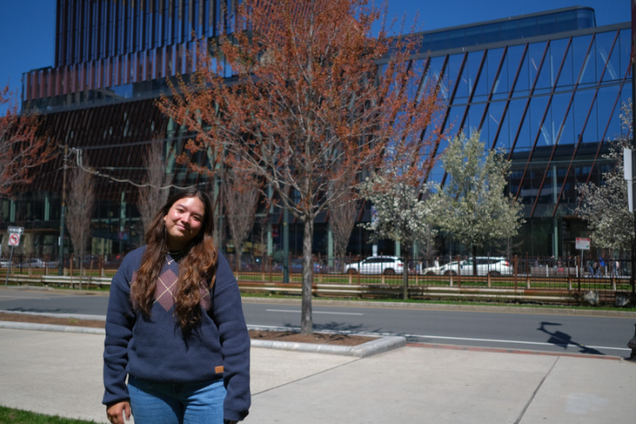
Hi there! My name is Isabella Boncser, and I'm currently a sophomore in the six-year Accelerated BS/DPT program in Boston University's Sargent College (2026/2028). In addition to my academic pursuits, I have a passion for photography, and am currently the CDS student event photographer. I love capturing student life within CDS, whether that be taking pictures of students studying in the building on a rainy day, attending 24-hour civic tech hackathon on the 17th floor, or a faculty and staff appreciation event. Over this past semester, I had the honor of working with the CDS communications team, led by Maureen McCarthy , director, and Alessandra Augusto , events & communications manager.
I was asked to highlight some of my best and brightest work from the semester. The following images were captured this spring, and are some of my favorite images. They showcase the versatility of student life within CDS and BU Spark !
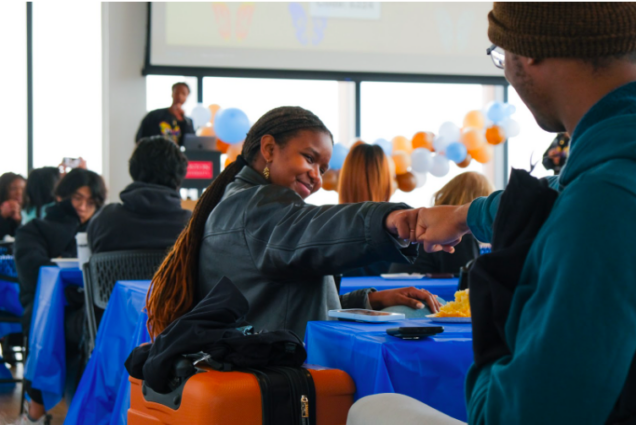
BU Spark! hosted a Tech For Change Civic Tech Hackathon , where students spent 24 hours at BU to developed a new project with teamwork and technical skills at the forefront. I had the opportunity to meet students from 19 different schools, all of whom spent (literally) day and night on the 17th floor of the Center for Computing & Data Sciences working together and using their hacking skills to create a difference in the world. Pictured here are two students celebrating after discussing their individual projects and asking for some advice regarding their presentations.
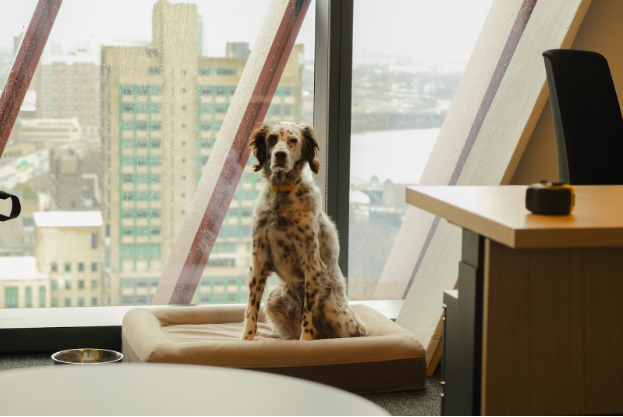
CDS serves as home for a variety of people and their furry friends! This image shows Miss Belle, the beautiful English Setter (who loves birds) who shares office space with her owner, Chris DeVits, CDS Director of Administration.
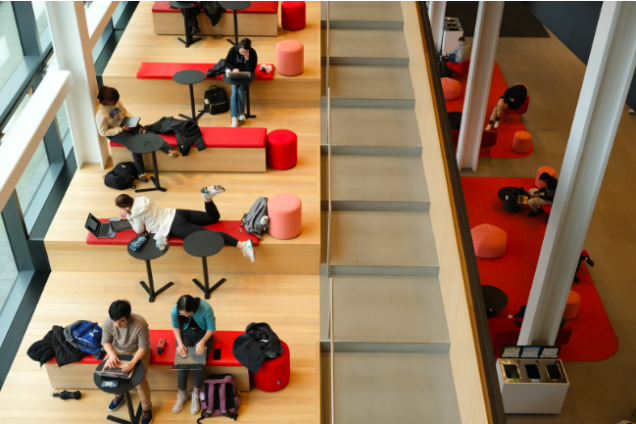
The Center for Computing & Data Sciences truly has a place for everyone at BU. The main level has become the campus living room, where students can meet to chat over coffee, or catch up on emails on the staircase. On a rainy day, students can find a " cozy corner " and focus on their work in a relaxing environment. This is a glimpse of the "sit steps" - the large staircase with over two dozen conversation spaces that has become popular for students to relax and get some work done between classes.
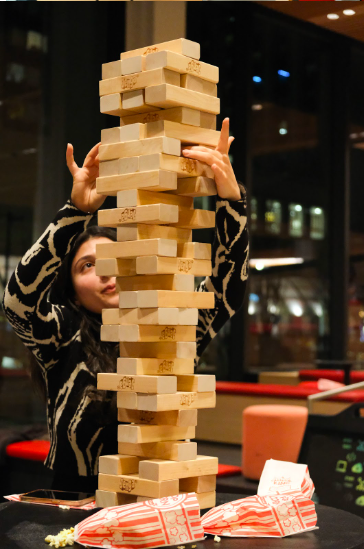
You may have heard people refer to the Center for Computing & Data Sciences as the "Jenga Building" because of its Jenga-like architecture. The building, which is home to the Faculty of Computing & Data Sciences, the Departments of Mathematics & Statistics and Computer Sciences, and the renowned Rafik B. Hariri Institute for Computing and Computation Science & Engineering, embraces its beautiful yet fun architecture while focusing on community! Next time you are craving a fun study break, join the CDS Events Team for a night of Jenga and try some delicious popcorn!
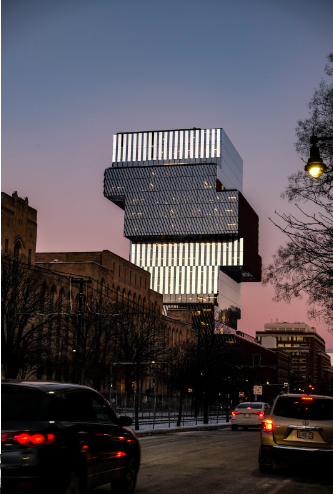
Driving down Commonwealth Avenue, the building stands out amongst its peers and shines bright along the Boston city skyline. Illuminating the streets during dusk, the building is one of my favorites the photograph. The 17th floor is home to many events hosted by CDS faculty and staff, as well as the general BU community.
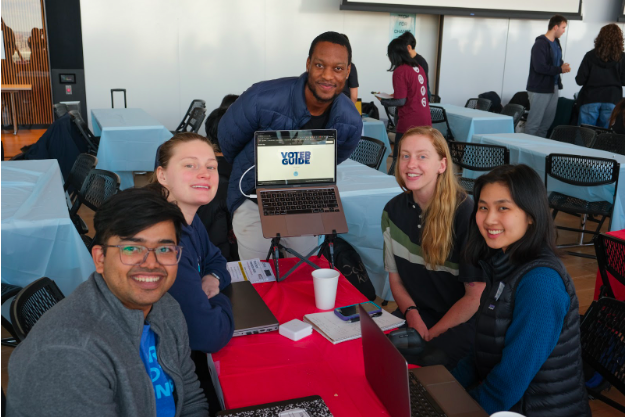
The students pictured had been working tirelessly on their TFC Civic Tech Hackathon project. This photo exemplifies teamwork, collaboration, and partnership. Although students were working on their projects for 24 hours on the 17th floor of CDS, they were all smiles for the camera during final presentations!
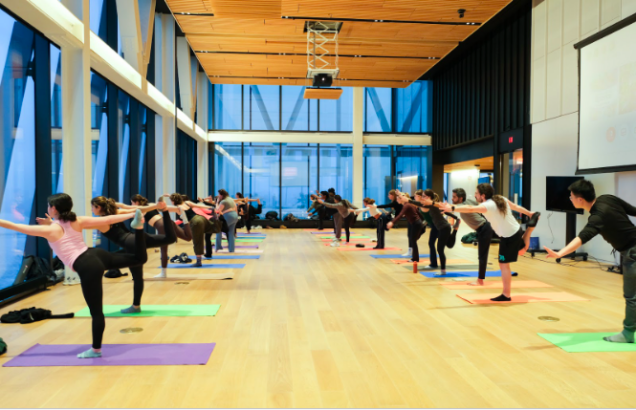
Yoga at the Top of BU has become a staple for students to come and enjoy a one-hour yoga session. The class is open to all students across BU, and is a great way to take a study break and get your body moving. If you are a zen master, or have never taken a yoga class before, come join us for the next session!
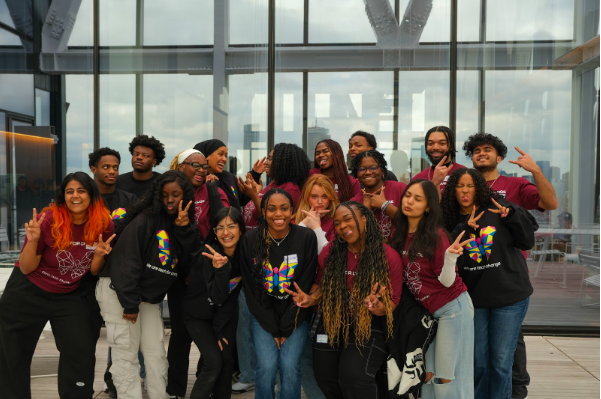
The BU Spark! team gathered for a group picture during the Civic Tech Hackathon which took place on the 17th floor in February. Over the Spring 2024 semester, I've had the pleasure of getting to know the ambassadors from each track, and their passion for their work within the BU community is truly inspiring. BU Spark! hosts numerous events, talks, and community-building programs like Cookie O'clock, town halls, and much more. Visit the BU Spark! space on the second floor to learn more about their involvement on campus!
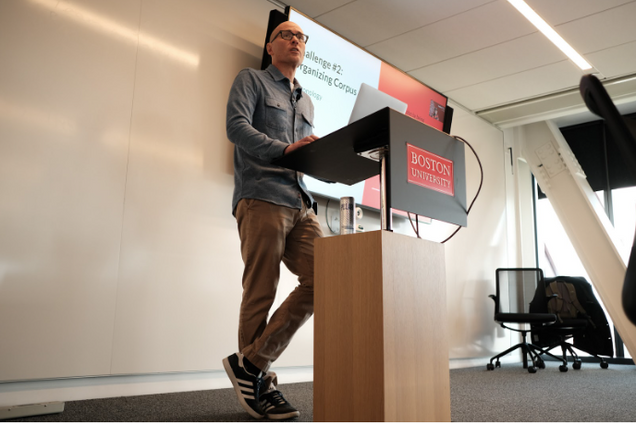
Computational Humanities, Arts & Social Sciences ( CHASS ) hosted a variety of tutorials ranging from "An Analysis on Emerson's Work" to large language model discussions throughout the Spring 2024 semester. These sessions are a great way to learn about the data science industry and how your skills will be used in the real world. Check out the CHASS video tutorial library on YouTube .
I am heading to Dublin, Ireland to live and study abroad for the Fall 2024 semester! I am so thankful to Maureen McCarthy who gave me the opportunity to work with and celebrate the CDS community. I would also like to shoutout Sebastian Bak (QST'25) who recommended the position to me, and spoke so highly of the CDS community!
Share this:
- Share on Facebook (Opens in new window)
- Click to share on LinkedIn (Opens in new window)
- Click to share on Twitter (Opens in new window)
View all posts
THE WIDER IMAGE
For turkish performer, drag is a political act.
Drag performer Ilker Yazici, 23, gets ready to shoot a sequence for a TV series in Istanbul, Turkey, July 25, 2023. REUTERS/Dilara Senkaya
By Dilara Senkaya
Filed April 4, 2024, 3:19 p.m. GMT

Photography by Dilara Senkaya Reporting by Burcu Karakas
Filed: May 1, 2024, 8 a.m. GMT
Ilker Yazici - stage name Miss Putka - was in secondary school when he discovered he was gay.
There he met LGBT advocacy groups and joined street protests in Turkey’s capital Ankara to defend LGBT rights, carrying rainbow flags.
“At first I struggled with myself a lot,” he said. “You grow up in the Middle East. It is not easy. I felt like I was the only one, just like most LGBT people feel.”
Ilker, now 23, never felt the need to hide, however and went on to celebrate who he is. Inspired by “RuPaul’s Drag Race” series on Netflix, he sees drag performance as an act of self-expression rather than just entertainment.
“Drag is a political act. The audience probably look at me and think, ‘What is this freak doing?’ I’m getting them used to seeing something they are not used to seeing.”

Many in Turkey’s LGBT community live in fear after last year's election campaign when President Tayyip Erdogan described LGBT groups as deviants and vowed to strengthen traditional family values. Homosexuality is not a crime in Turkey, but hostility to it is widespread.
Ilker’s conservative father is unaware of the drag life: although other relatives found out about the performances - which take place every Friday and Saturday night - no one has dared to tell him.
“When I go on stage as a drag queen, the make-up makes me feel like I am hiding behind a mask,” Ilker said. “Miss Putka is a confident person, very open to communication. I am not.”
Ilker studies industrial design at Marmara University in Istanbul but is considering studying performing arts in Spain. “You can perform as long as you are healthy. I’ll do it as long as I’m able,” he said.
He has no worries about performing drag, but living in Turkey does worry him.
“I don’t know what the future will hold for me here,” he said. “It is so unpredictable.”

‘You have to behave with respect’
Ilker never thought he would become a drag artist on the day that, as a teenager, he stole his mother’s black sequined blouse from her closet to perform on stage for the first time in 2019.
He was preparing for the university entrance exam at the time, and left home at night by telling his parents he forgot a book at the library.

“I cut a pair of black jeans into shorts and wore them under my mother’s blouse with silver-coloured seven-centimetre heels and a bonus lilac wig I borrowed from a friend,” he said.
“Despite my terrifying make-up and costume, the audience applauded like crazy and I felt like a star.”
Born and raised in Ankara, he traveled for two years across the country to appear at gay life magazine GZone’s events. It was then that he began to buy costumes and shoes from second hand stores and flea markets.

When Miss Putka, whose name comes from a slang word for vagina, began to take the stage at XL, a night club in Istanbul, it was no longer a hobby but a regular job. Before his first professional show at the club, he was trained for a month by Russian dancers with whom he shared the stage.
“The venue is huge. I’ve got dancers behind and a tailor ready to do what I want,” he said.
At first he was annoyed by customers who ignored his performance and treated him rudely when he visited their tables. But he learned how to deal with it.
“I started to say, ‘I work here and you have to behave with respect’. They apologized.”

He became the stage manager, coordinating a team of about 15 people. Experienced drag performers advised him to use choreography to tell a story and also broaden the shows’ appeal. That is how he began playing popular Lady Gaga songs.
Miss Putka’s nun-like outfit with a bright red cross on her head was inspired by American singer Todrick Hall, who was a choreographer and judge on “RuPaul’s Drag Race”. Although this five-minute performance is the most acclaimed, it is not his favourite.
“I love the one where I shoot flames from my conical breasts while singing Rihanna songs.”

The Wider Image
Photography and reporting: Dilara Senkaya
Reporting: Burcu Karakas
Photo editing and design: Eve Watling and Maye-E Wong
Text editing: Jonathan Spicer and Philippa Fletcher
LICENSE THIS STORY
- Follow Reuters Investigates
Other Reuters investigations

Roger Corman: a career in pictures
- Share on Facebook
- Share on Twitter
- Share via Email
Best known for his low-budget Edgar Allan Poe adaptations, Corman also produced over 400 films and helped kickstart the careers of Jack Nicholson, Nicholas Roeg, Peter Fonda, James Cameron and Martin Scorsese
- News: Corman dies aged 98
- Peter Bradshaw’s appreciation
- Roger Corman obituary
Greg Whitmore
Sun 12 May 2024 08.59 BST Last modified on Sun 12 May 2024 22.07 BST
Photograph: Hulton Archive/Getty Images

Day The World Ended, 1955
Photograph: Alamy

The Undead, 1957
Photograph: The Kobal Collection

Not Of This Earth and Attack Of The Crab Monsters, both 1957
Composite: Movie Poster Image Art/ Getty Images

Attack of the Crab Monsters, 1957

Teenage Doll, 1957
Photograph: Everett/REX Shutterstock

The Wasp Woman, 1959
Photograph: Moviestore/REX Shutterstock

The Fall of the House of Usher, 1960

The Little Shop of Horrors, 1960

The Pit and the Pendulum, 1961

X: The Man with the X-Ray Eyes, 1963
Photograph: Public Domain

Tomb of Ligeia, 1964

The Masque of the Red Death, 1964
Composite: BFI

The Wild Angels, 1966

Photograph: Ronald Grant Archive

The St. Valentine’s Day Massacre, 1967
Composite: REX Shutterstock/Alamy

The Trip, 1967
Photograph: Movie Poster Image Art/Getty Images

Bloody Mama, 1970
Composite: REX/Ronald Grant Archive

Photograph: Getty Images

Frankenstein Unbound, 1990
Composite: REX Shutterstock

Photograph: Michael Yada/Getty Images

Photograph: Victoria Will/Invision/AP

- Roger Corman
- Horror films
- Science fiction and fantasy films
- Edgar Allan Poe
More galleries
View all comments >.
- recommendations
Most popular
In photos: At least 83 dead as historic flooding hits southern Brazil
By Jintak Han | May 7, 2024
Record-breaking floods in Brazil’s southern Rio Grande do Sul state have killed at least 83 people over the past week, and another 111 were reported missing, local authorities said Monday.
Renan Mattos/Reuters
In the state capital, Porto Alegre, water levels of the Guaíba River peaked at 17.5 feet (5.33 meters) on Sunday — far exceeding the previous record of 15.6 feet (4.76 meters) observed in 1941, according to the prefectural government.
At least 291 people were injured, while damage from the rains forced more than 129,000 people from their homes. Approximately 20,000 took refuge in schools, gymnasiums and other temporary shelters.
May 6 | Porto Alegre, Brazil
An aerial view of the flooded Beira-Rio Stadium.
A group of volunteers on a flooded street.
Giulian Serafim/AFP/Getty Images
A car is filled with water on a flooded street in the Menino Deus neighborhood.
A military truck transports people out of the flooded area.
Nelson Almeida/AFP/Getty Images
Volunteers help residents evacuate from their homes in the Farrapos neighborhood.
May 5 | Porto Alegre, Brazil
An area after the flooding of Guaíba River.
May 5 | Canoas, Brazil
People are rescued after flooding.
Amanda Perobelli/Reuters
People are rescued by residents.
Rescue workers evacuate a flood victim.
A flooded street.
Anselmo Cunha/AFP/Getty Images
People wade through floodwaters.
People walk through floodwaters.
May 5 | Roca Sales, Brazil
Houses destroyed by floods.
Gustavo Ghisleni/AFP/Getty Images
May 5 | Jacarezinho, Brazil
People walk inside a shop destroyed by flash floods.
Diego Vara/Reuters
May 5 | Encantado, Brazil
An injured dog lies in the mud after heavy rains and floods.
Volunteers provide food, medical attention and clothing to people rescued from flooded houses at a gas station used as a meeting point.
Carlos Fabal/AFP/Getty Images
Julio Manichesque walks on the roof of his house after floods.
A flooded area after the flooding of Lake Guaiba.
May 4 | Porto Alegre, Brazil
A woman is evacuated from a flooded area.
May 4 | Canoas, Brazil
Rescue teams and volunteers help flood victims.
Alisson Moura/AFP/Getty Images
A man is rescued by military firefighters.
May 4 | Roca Sales, Brazil
A man is rescued after being injured during the floods.
May 3 | Eldorado do Sul, Brazil
Floodwaters overtake the streets.
May 3 | Porto Alegre, Brazil
A man wades through a flooded section of the city.
Carlos Macedo/AP
Residents of coastal islands near the shore of Lake Guaíba carry their belongings after being rescued.
Isaac Fontana/EPA-EFE/Shutterstock
May 2 | Encantado, Brazil
A woman carries two rescued cats.
People and a dog are rescued from the islands of Lake Guaíba.
May 1 | Encantado, Brazil
Houses next to the Taquari River are submerged by floodwaters.
May 1 | Sinimbu, Brazil
A house partially destroyed by heavy rains.
A resident climbs a rescue truck.
May 3 | Encantado, Brazil
A woman walks through mud as she tries to get to her house.
May 2 | Lajeado, Brazil
Two men are rescued by military firefighters.
Jeff Botega/Agencia RBS/Reuters
People throw bags across a puddle as they evacuate flooded areas.
Vehicles covered in mud.
Horses wade through a flooded beach along the Jacui River.
People and their pets are rescued from the flooding.
Renan Mattos/EPA-EFE/Shutterstock
Residents are rescued by the Brazilian army.
Displaced people take shelter in a public facility.
A displaced person rests at a shelter.
More from the Post
Historic floods kill 83, leaving Brazil and its president shaken, angry
The new face of flooding
The latest from The Washington Post
Photo editing and production by Jintak Han and Troy Witcher

IMAGES
VIDEO
COMMENTS
His powerful photo essay, "We Are Here Because We Are Strong", was commissioned by UNHCR, the UN Refugee Agency, and published in Humanity magazine. Duley is a longtime collaborator with UNHCR and his previous projects for the agency include documenting the arrival of Syrian refugees in Greece in 2015.
His powerful photo essay, ... In a UNHCR settlement in Lóvua, where the photos were taken, 75 per cent of the Congolese refugees are women and children. The subjects of his project were forced to flee the Kasai region of Democratic Republic of the Congo after violence erupted in March 2017, triggering massive displacement; over 34,000 refugees ...
Nearly 700,000 people have been forced from their homes in Afghanistan since the beginning of 2021, joining 2.9 million Afghans already internally displaced across the country at the end of 2020 ...
M illions of Syrians have fled fighting over the past 10 years.The vast majority of refugees - more than 3.5 million - are living in Turkey, but more than 850,000 are living in informal ...
In March 2013, 156,000 people were living in a space designed for 113,000. The windswept camp had become Jordan's fourth largest city, and UNHCR's second largest camp after Dadaab in Kenya, currently home to about 328,000 displaced Somalis. Today, of the close to 700,000 registered Syrian refugees in Jordan, Za'atari houses about 80,000 ...
The following photo essay explores the theme of displacement through images from my time in several informal refugee settlements in the Beqaa Valley, Lebanon during November 2018. The UNHCR reports over 1 million registered refugees living across Lebanon in host communities or informal tented settlements, with the highest concentration in the ...
Burundi's ongoing political turmoil has caused hundreds of thousands to flee their homes and seek shelter in neighbouring Democratic Republic of Congo (DRC). At the Lusenda refugee camp, which is home to more than 16,000 refugees, the majority are women and girls. Hundreds of refugees have come to the Safe Haven multipurpose centres for protection and economic and social empowerment ...
UNICEF/UN068523/Oatway. Agnes holds a hat that belonged to her late son. Agnes holds her baby boy's knitted hat in the Bidibidi refugee settlement, north-western Uganda. She fled South Sudan, in the midst of conflict, where the war and instability had created a severe food crisis.
Hundreds of millions of babies are expected to be born during the COVID-19 pandemic. Fionn, son of Chloe O'Doherty and her husband Patrick, is among them. The couple says: "It's all over. We did ...
Yemeni refugees seek shelter in Djibouti (Photo Essay) Oualid Khelifi, Al Jazeera, 14 Nov 2015. URL ... (ODP) enables UNHCR's institutional responsibility to provide an information and data sharing platform to facilitate coordination of refugee emergencies. This was achieved using independent 'situation views' covering major emergencies ...
Written by MasterClass. Last updated: Jun 7, 2021 • 5 min read. Photo essays tell a story in pictures, and there are many different ways to style your own photo essay. With a wide range of topics to explore, a photo essay can be thought-provoking, emotional, funny, unsettling, or all of the above, but mostly, they should be unforgettable.
Yemeni refugees seek shelter in Djibouti (Photo Essay) Oualid Khelifi, Al Jazeera, 14 Nov 2015. URL ... (ODP) enables UNHCR's institutional responsibility to provide an information and data sharing platform to facilitate coordination of refugee emergencies. This was achieved using independent 'situation views' covering major emergencies ...
Photo essay: The reality for those fleeing Ukraine. More than 1 million people have fled Ukraine in just the first week of conflict, and thousands more are on the move. ... The UNHCR estimates it could be the biggest refugee crisis of the century. Most of the refugees crossing the border into Poland, Slovakia, Romania, Hungary, and Moldova are ...
Our analysis shows that UNHCR visually mainly represents helpless and anonymous Ukrainian and Syrian women and children (Figures 1 and 2), corresponding with previous findings on ideal victims (Höijer 2004; Jhoti and Allen 2024).Hence, UNHCR can potentially more easily generate strong emotions of pity and guilt and subsequently awareness and donations (Höijer 2004; Scott 2014).
3. Take your time. A great photo essay is not done in a few hours. You need to put in the time to research it, conceptualizing it, editing, etc. That's why I previously recommended following your passion because it takes a lot of dedication, and if you're not passionate about it - it's difficult to push through. 4.
The 'Lift' star and Goodwill Ambassador for UNHCR, the UN Refugee Agency penned a personal essay on a cause close to her heart. UNHCR Goodwill Ambassador Gugu Mbatha-Raw visits the home of Vicky ...
Photo essay: Annual house walk opens doors of historic homes. Evanston History Center provides detailed history of homes in annual Mother's Day event. by Alex Harrison May 12th, 2024. The Evanston History Center held its 49th Annual Mother's Day House Walk on Sunday, allowing residents to learn about and explore five historically and ...
UNHCR, the UN Refugee Agency, pays tribute in this photo essay to their strength and resilience. Racheal Athieng, 20, was forced to flee her home in Twic East, South Sudan. She settled in Mingkaman and now teaches a class of fellow Internally Displaced People (IDP) at the newly-built school. "Women teachers have the advantage that they identify ...
Photo Essay: My Spring 2024 Semester at CDS. Hi there! My name is Isabella Boncser, and I'm currently a Sophmore in the Six-Year Accelerated BS/DPT program in Boston University's Sargent College (2026/2028). In addition to my academic pursuits, I have a love for photography, and am currently the CDS student event photographer. I love capturing ...
Ilker poses for a photo outside a nightclub during an event in Istanbul, Turkey, September 24, 2023. REUTERS/Dilara Senkaya Ilker shops at a local market in Istanbul, Turkey, March 13, 2024.
Best known for his low-budget Edgar Allan Poe adaptations, Corman also produced over 400 films and helped kickstart the careers of Jack Nicholson, Nicholas Roeg, Peter Fonda, James Cameron and ...
UNHCR spokespeople are available at our headquarters in Geneva, our regional offices and in many of our field operations to answer media enquiries and provide interviews. Our content team provides videos and photographs free of charge to the media via Refugees Media . Follow our senior leaders and global accounts for timely updates on social media.
In photos: At least 75 dead as historic flooding hits southern Brazil. By Jintak Han | May 6, 2024. Massive floods in Brazil's southern Rio Grande do Sul state have killed at least 75 people ...